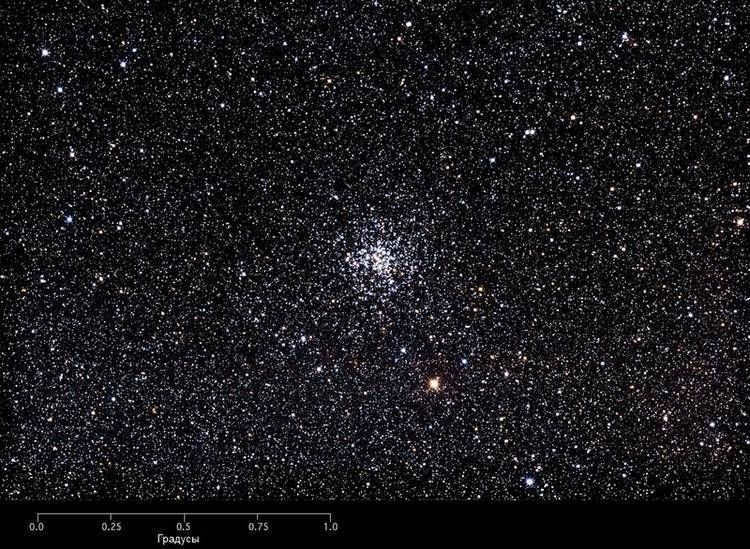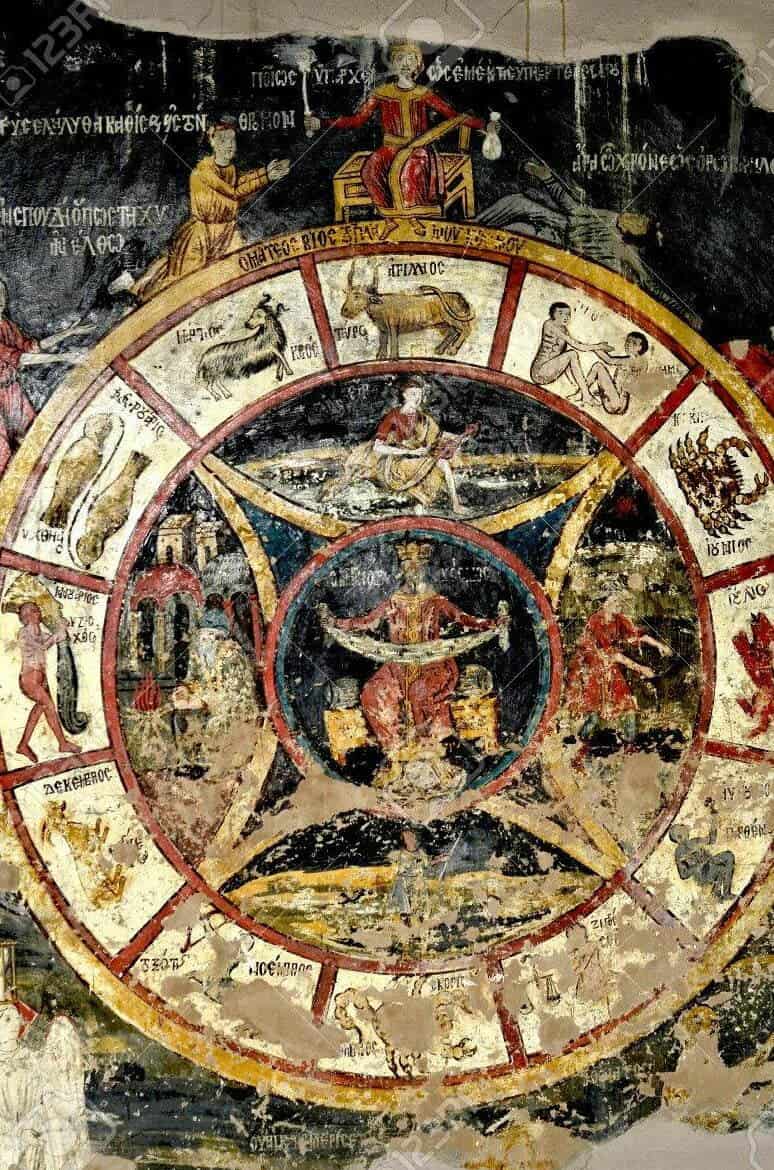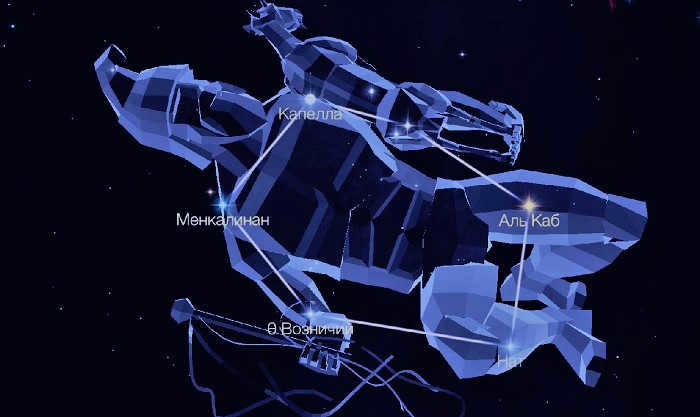
Ascendant is one of the oldest star formations in the night sky. Its most notable celestial body, Capella, can be observed for almost the entire year.
Summary
The star formation known as Ascendant, or Auriga in Latin, takes the shape of a pentagon, with the brilliant Capella situated at its apex. Ascendant covers an area of 657 square degrees in the celestial sphere and is the 21st largest out of the 88 recognized star formations.
To locate Ascendant, one can trace a line from the stars Alpha and Delta Minor of the Little Bear, heading eastward towards the constellation Perseus. To the left of Ascendant lies the constellation Gemini, while below its feet lie Orion and Taurus.
During the summer months, Ascendant shifts its position from north to northeast. In the central region of Russia, this star formation remains visible throughout the entire year, particularly from October to April.
Legends and Folklore
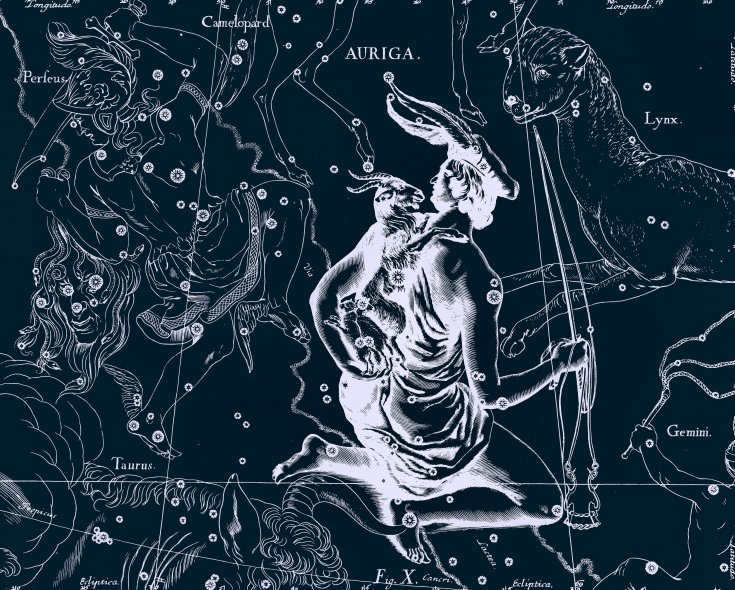
The mention of the stars in the Ascendant can be traced back to the ancient civilizations of Mesopotamia. Originally, this constellation was depicted as a shepherd herding a group of goats.
In ancient Greece, the figure of a charioteer was associated with the Ascendant. According to tradition, this constellation was represented as a man holding a whip and reins in one hand, and a goat and two goats in the other.
In Greek mythology, the goat was a symbol of Amalthea, the goat who nursed Zeus on the island of Crete while he was hiding from his father, Cronus. As a token of gratitude, Zeus immortalized the goat by placing it in the sky as a star in the Ascendant constellation.
The Charioteer himself, according to legend, is said to be the Greek ruler Erichthonius, who is credited with inventing the four-horse chariot.
There is a belief that the constellation is named after Automedontes, the hero from the Trojan War who drove Achilles’ chariot. The name Automedontes is derived from the word meaning a skilled charioteer. The constellation of Capricorn was described by Cleostratus of Cynedos and is included in Claudius Ptolemy’s Almagest catalog.
The primary celestial bodies
Ascendant is home to several extraordinary stars with exceptional characteristics.
Capella
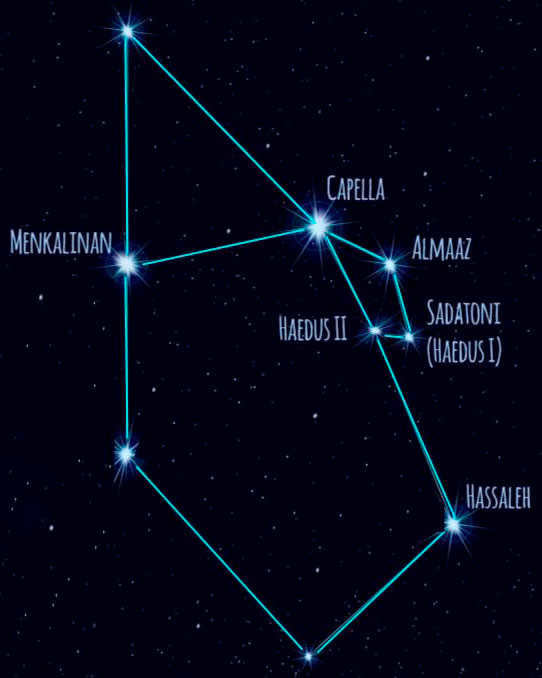
Alpha Ascendant, the brightest star in the constellation, is known as Capella, which means “goat” in Latin. It also goes by other names such as Amalthea, Hyrkus, and Alhayot.
Located on the right shoulder of the human figure near the top of the constellation, Capella can be easily spotted between Gemini in the west and Perseus in the east. It shines the brightest in this part of the sky.
Capella ranks as the 6th brightest star overall and the 3rd brightest star in the northern hemisphere. It is situated at a distance of 42.9 light years from Earth. This star is actually a multiple star system, consisting of two giants, Alpha Aa and Alpha Av, and two red dwarfs, Alpha H and Alpha L.
The two giants are separated by a distance of 100 million kilometers and have a rotation period of 104 days. They orbit around a common center of mass in elliptical orbits.
Capella Aa is currently undergoing a transformation into a red dwarf, as it transitions from being a yellow-orange giant. The process of helium burning has commenced within its core. This star has already experienced significant expansion, reaching a size of 15 solar radii. As its surface temperature decreases, it is now below 5000K. In terms of brightness, Alpha Aa boasts a luminosity of 78 solar luminosities. It can be observed with an apparent stellar magnitude of 0.08m.
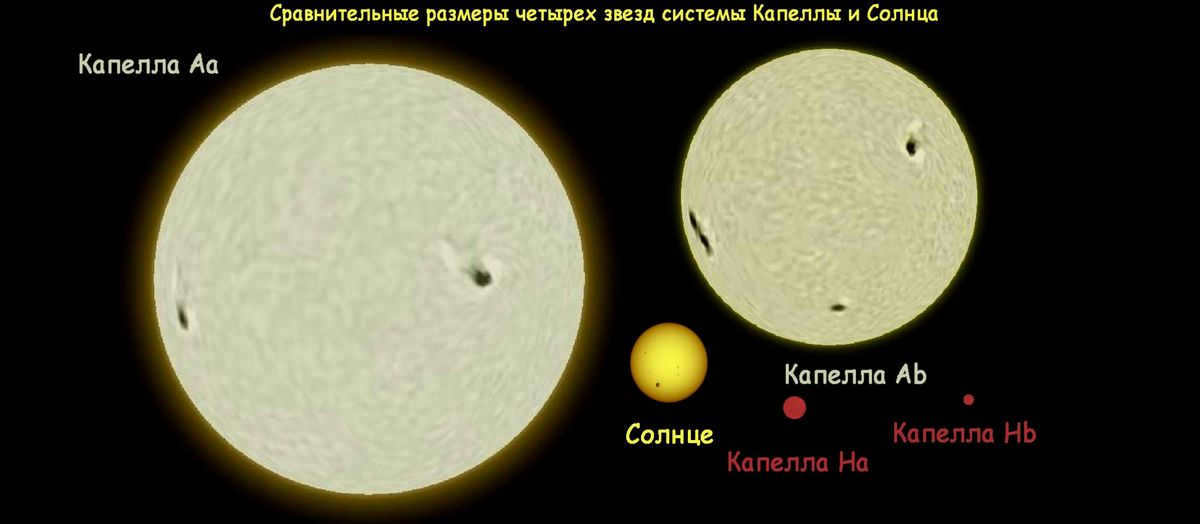
The star known as Capella is currently in the stage of being a white-yellow giant and has not yet transitioned into a red dwarf. It has already completed its hydrogen fusion reactions in the core, but has not yet started the helium reactions. At this point, Capella has expanded to a size of 9 solar radii, with a surface temperature of approximately 5750K and a luminosity 72 times that of the Sun. Capella is estimated to be around 5.5-5.9 billion years old and has an apparent stellar magnitude of 0.6m.
Beta Ascendant
Rising Above the Rest
Experience the future with Beta Ascendant, the leading provider of innovative solutions for businesses and individuals. Our team of experts is dedicated to helping you reach new heights and achieve your goals.
At Beta Ascendant, we believe in pushing boundaries and challenging the status quo. We offer cutting-edge technologies and forward-thinking strategies that will set you apart from the competition.
With our advanced tools and personalized approach, we empower you to exceed expectations and surpass your own limitations. Our solutions are designed to maximize efficiency, optimize performance, and drive sustainable growth.
Join Beta Ascendant and join the ascendance. Together, we can redefine what is possible and create a brighter future. Contact us today to learn more about our services and start your journey towards success.
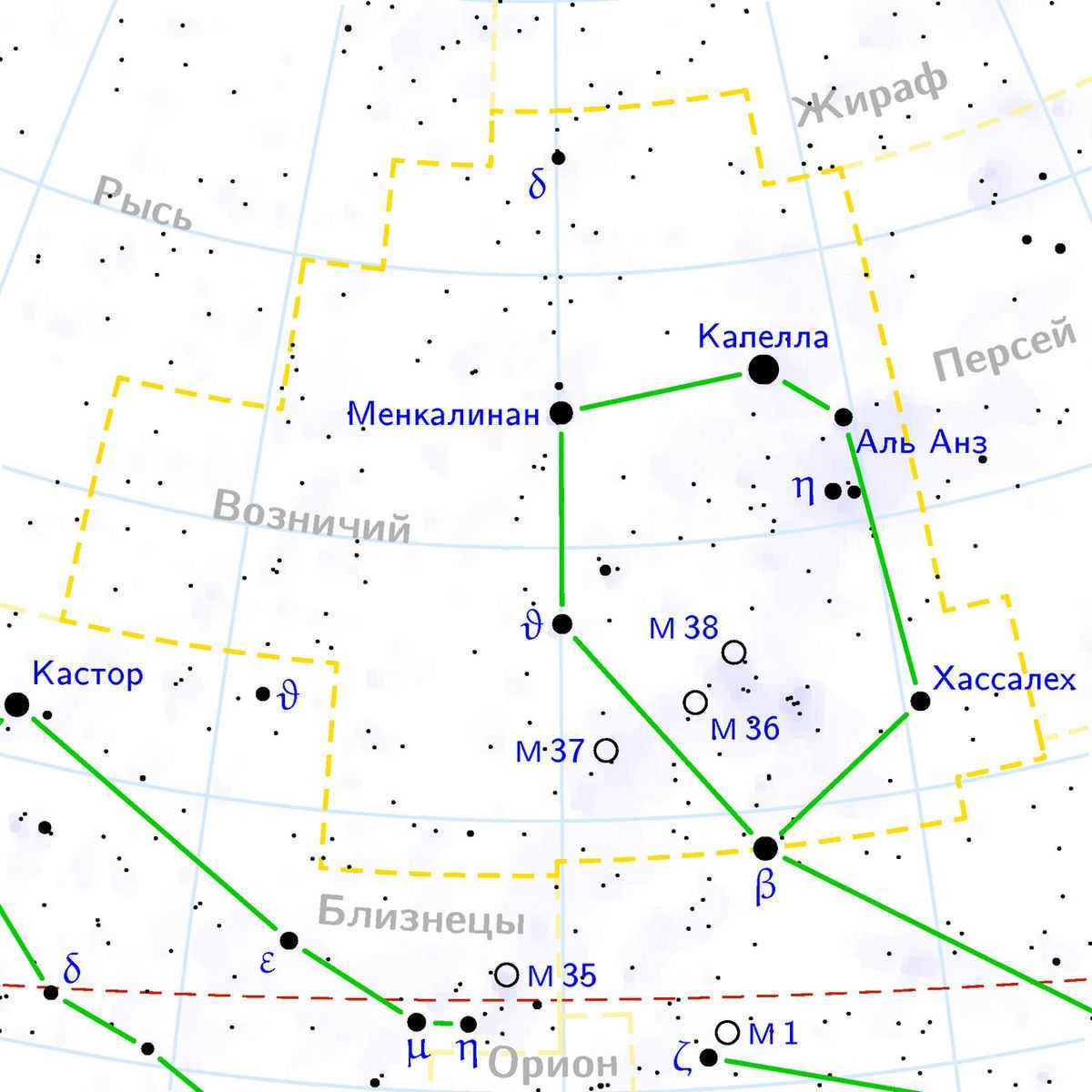
Menkalinan, also known as Beta Ascendant, is a binary system composed of two stars that have nearly identical physical characteristics. The distance between these stars is comparable to the distance between the Sun and Mercury, which is approximately 0.08 astronomical units (a.u.).
The distance from Beta Ascendant to Earth is approximately 82 sv years. Each star has a visible magnitude of around 1.9 m, and they are both approximately 48 times brighter than our Sun. The surface temperature of Menkalinan is estimated to be around 9000K.
Every 4 days, one star passes in front of the other, resulting in a partial eclipse from our perspective. These stars are currently in a subgiant phase and will eventually evolve into red dwarfs. They are in close proximity to each other and are always facing the same side.
Iota
Also known as Hassaleh, Al Qab, and Qabdillinan, Iota is positioned at the base of Mount Ascendant’s leg. With an age exceeding 40 million years, this star is currently undergoing the final stages of a thermonuclear reaction, where helium is transforming into carbon. It is anticipated that in the near future, Iota will either experience a supernova event or evolve into a white dwarf.
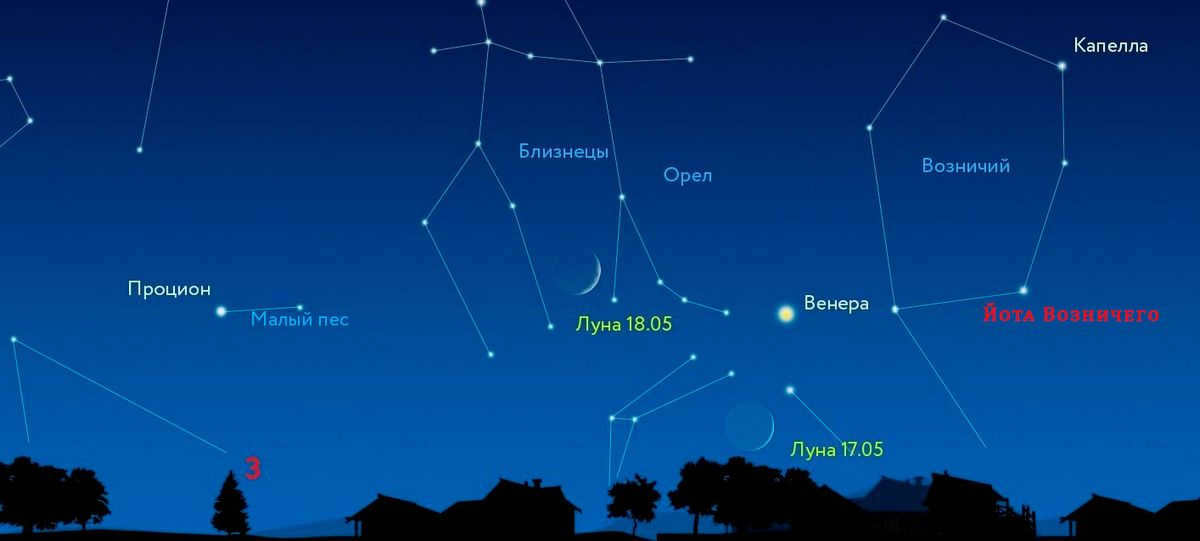
The star has a mass of approximately 8 times that of the Sun. Its apparent magnitude is 2.7m. Iota belongs to the K3II spectral class. The radius of Al-Kab is 127 times that of the Sun. The surface temperature is only 4200K.
The Sun’s surface temperature is 5900K.
Epsilon
Epsilon is a Greek letter that is commonly used in mathematics and science. It is often used to represent a small, positive number or a small change in a value. In set theory, epsilon is used to describe the smallest element in a set. Epsilon is also used in calculus to represent an arbitrarily small number that is approaching zero.
In addition to its mathematical uses, epsilon is also used in other fields. In computer science, epsilon is often used as a placeholder or a symbol for an empty string. In physics, epsilon is used to represent the permittivity of a material, which is a measure of how easily an electric field can pass through it.
Overall, epsilon is a versatile symbol that is used in a variety of contexts. Its use in mathematics and science helps to convey important concepts and relationships.
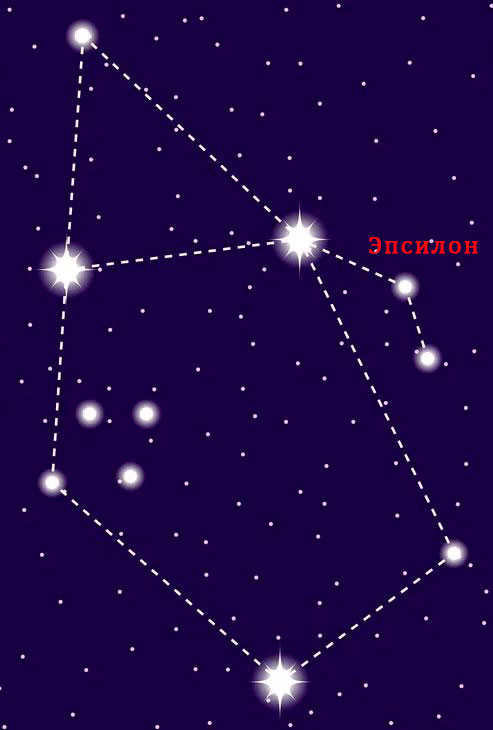
Adjacent to Capella, you can find the minuscule Epsilon of Ascendant. It is also known as Almaaz or Al Anz. This peculiar star has been captivating astronomers worldwide for over a century.
The brightness emanating from Epsilon appears to be constant, but suddenly the star dims and its light becomes 2-2.5 times fainter after a few months. This diminished state persists for a year and a half or two years. Then, it reignites and within weeks, it returns to its previous luminosity. This cycle repeats every 27 years.
Epsilon has a companion that orbits around it, periodically obstructing the star’s light. This results in an eclipse. Stars like Epsilon are referred to as eclipsing stars.
New research indicates that Epsilon, the satellite, is of minuscule size and has an extraordinarily close proximity to its star, rendering it nearly undetectable even with advanced telescopic technology.
Experts propose the notion that Epsilon is accompanied by a pair of diminutive satellites that orbit each other at an accelerated rate. This phenomenon has resulted in the creation of a gas and dust cloud that envelops the satellites. On occasion, during an eclipse, this cloud obscures the visibility of Epsilon. It should be noted that this concept remains purely speculative at this stage.
The Ascendant’s AE
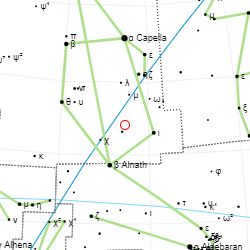
The AE star, also known as the Blazing Star, is known for its high speed movement. With an apparent magnitude of 6m, it is barely visible from Earth. Its mass is 17 times that of the Sun, and its radius is 5 times that of the Sun.
The AE star is classified as a variable star, with its luminosity ranging from 5.4 to 6.1. It belongs to the O9.5V spectral class. The luminosity of the Blazing Star is 30,000 times that of the Sun, and its temperature is around 31,000K. Scientists predict that the star will eventually become a supernova or a neutron star.
Engaging celestial entities
Astronomers are engaged in constant observation of captivating entities within the makeup of Ascendant. This constellation encompasses a diverse array of galaxies, nebulae, and exoplanets.
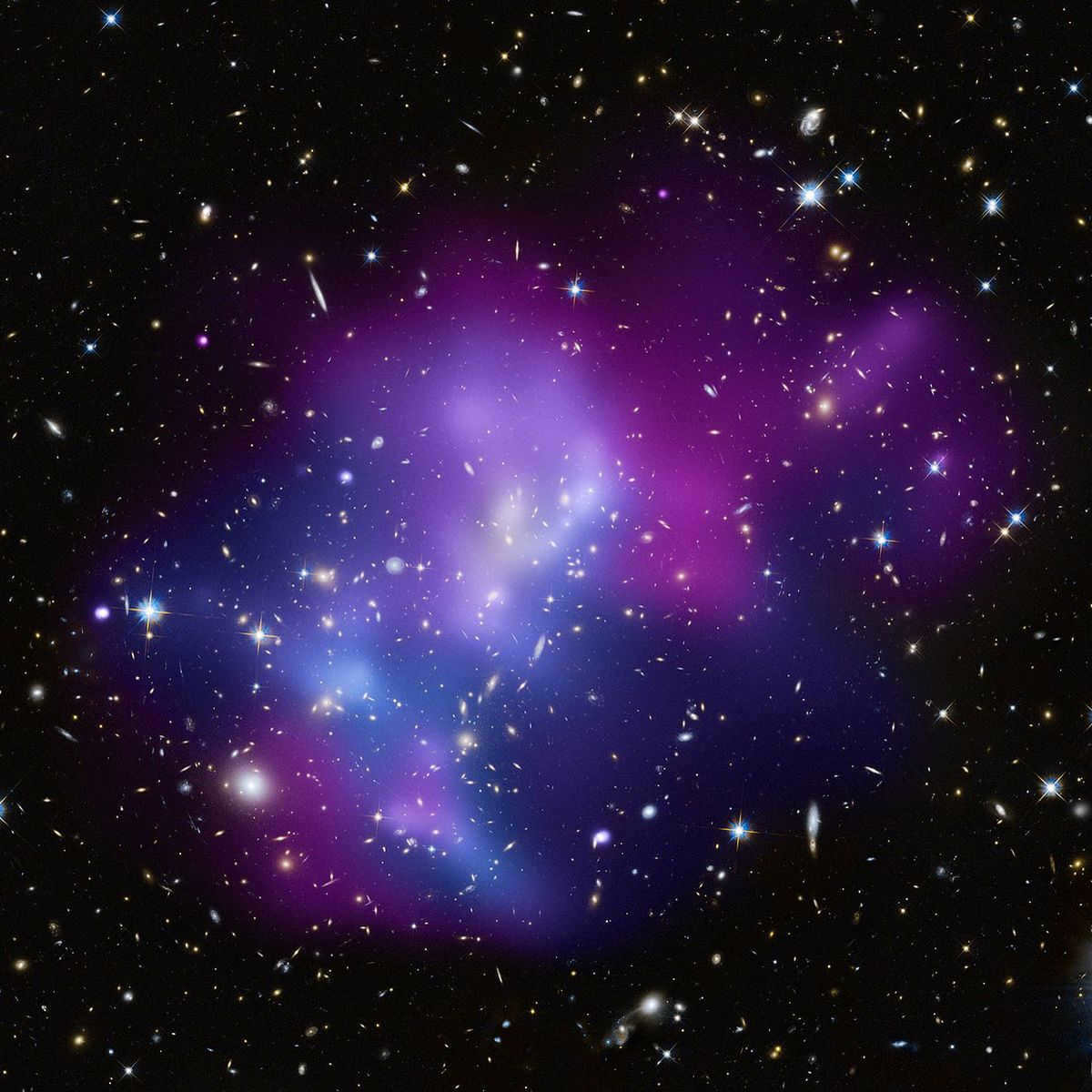
M36 (NGC 1960)
can be rephrased as
M36, also known as NGC 1960
.
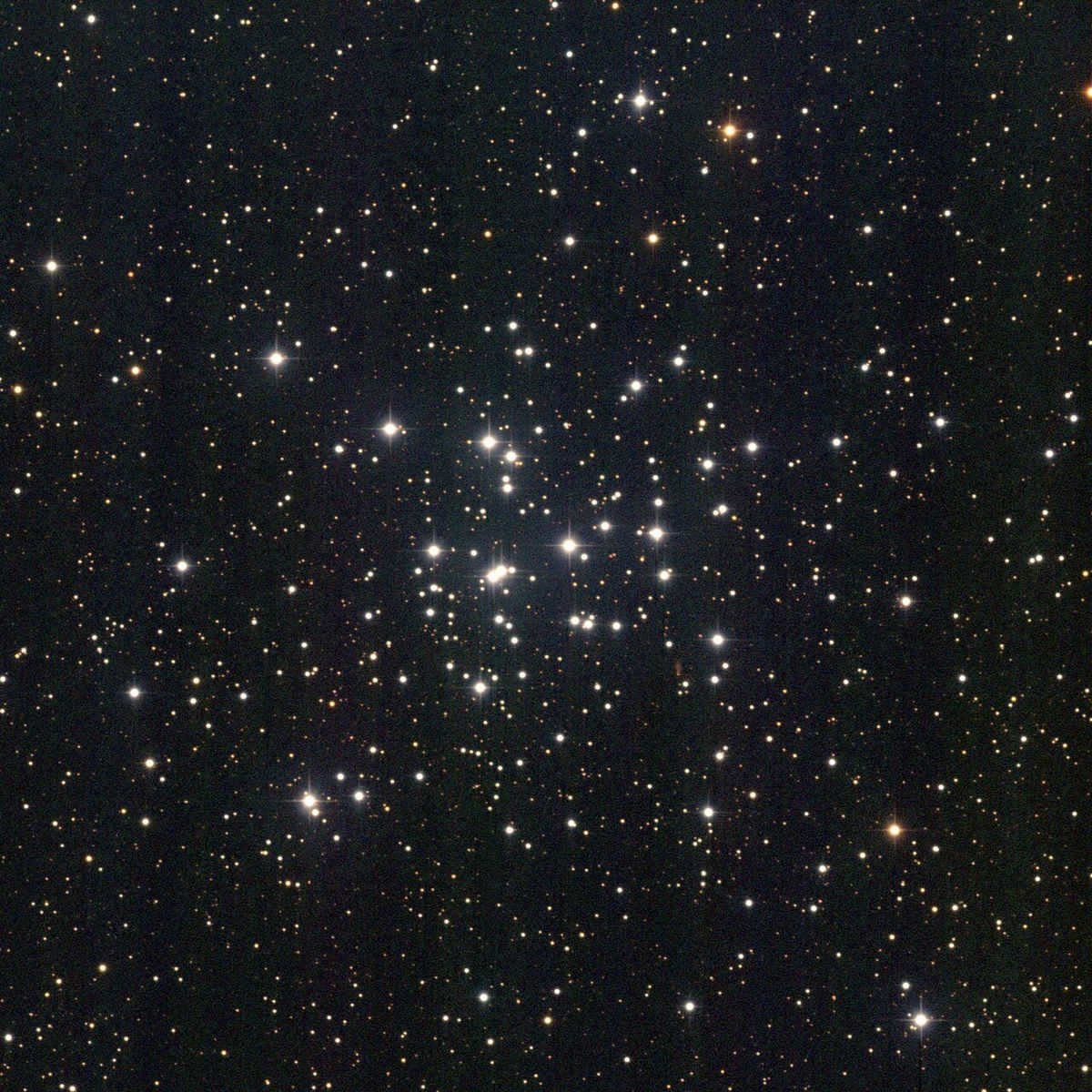
M37 (NGC 2099)
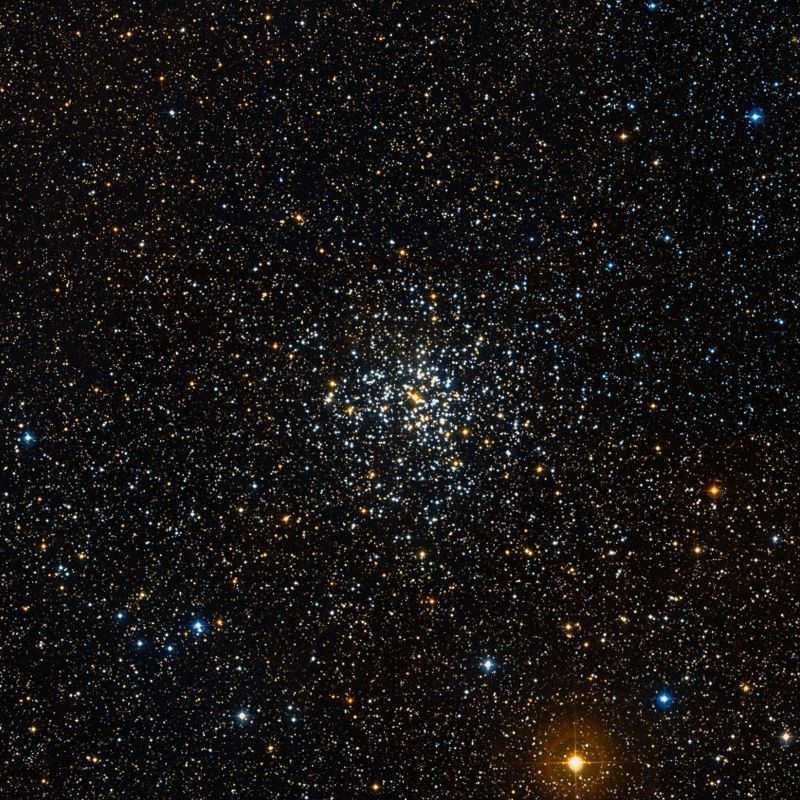
The galaxy cluster MACS 0717 is a notable object due to the presence of four merging galaxies within it. This collision has been ongoing for a considerable amount of time. Situated 5.4 billion light-years away from Earth, this cluster is located in the Ascendant constellation.
Within the Ascendant constellation, there are three consecutive open clusters known as M36 (NGC 1960), M37 (NGC 2099), and M36 (NGC 1912). These clusters are all located over 4 thousand light-years away from us. They contain young stars and are estimated to be of different ages, with M36 being approximately 25 million years old and M38 being around 220 million years old. Additionally, these clusters consist of stars from various classes, with M37 being the brightest among them.
M36 (NGC 1912)
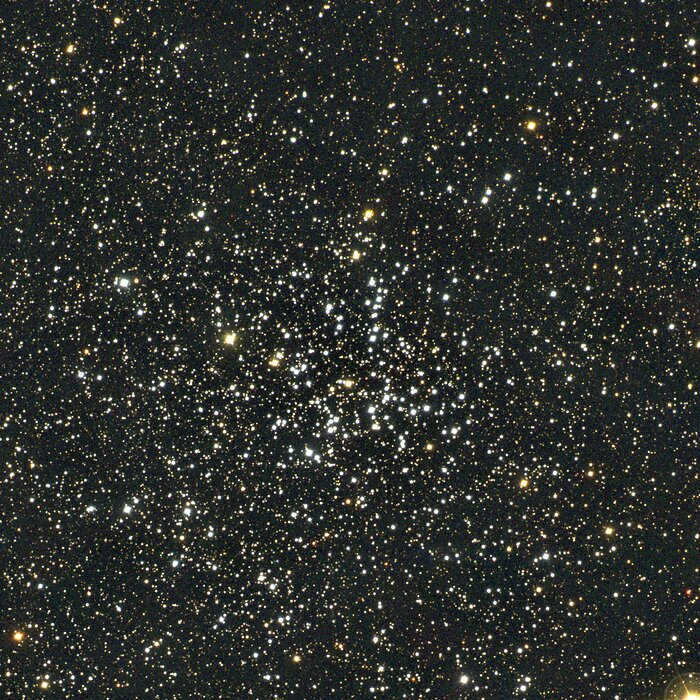
IC 405, also known as the Flaming Star Nebula, is a stunning celestial formation.
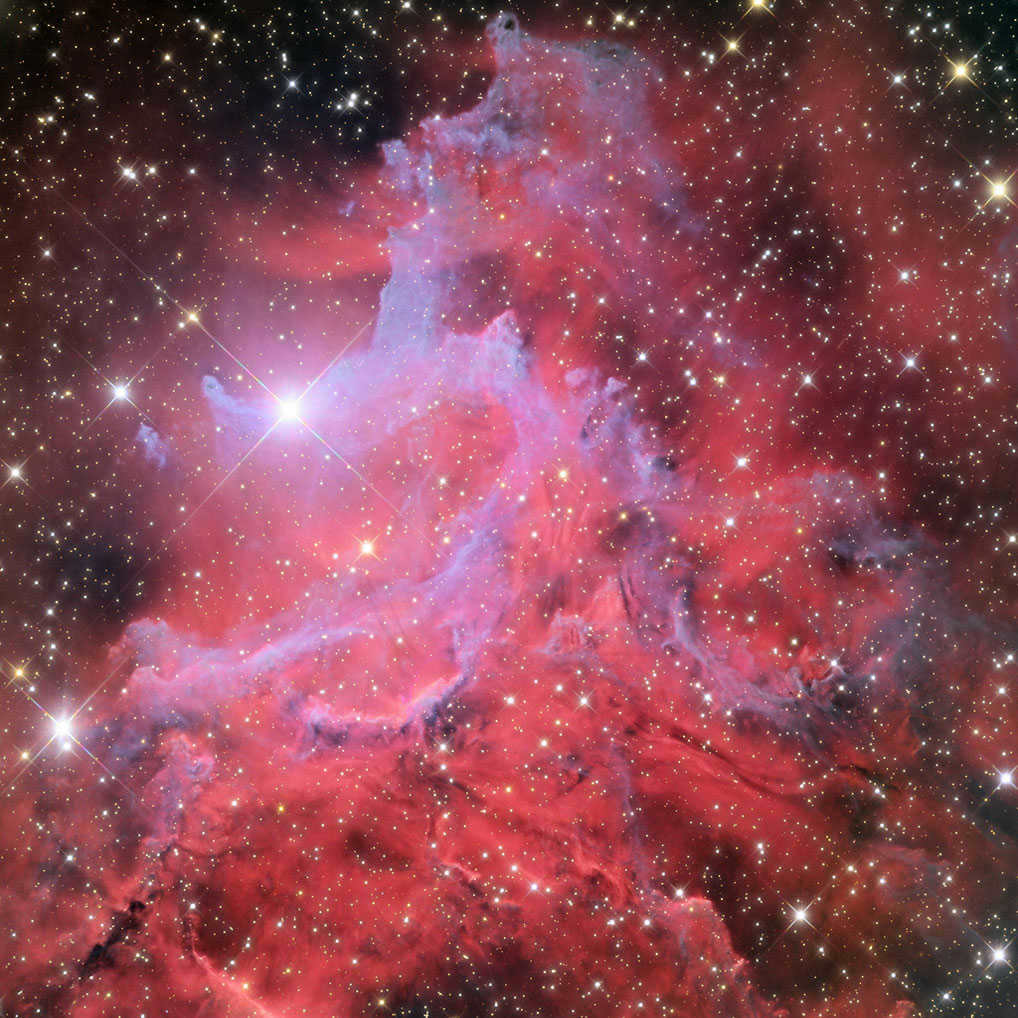
- Ascendant contains a small planetary nebula called IC 2149. When observed at low magnification, it resembles a star. However, at higher magnifications, it appears as an elongated nebula.
- Located near the AE of the Carrier, the Flaming Star Nebula IC 405 is visible. This reflection nebula is situated 1500 sv years away from Earth.
- The emission nebula IC 410 can be found in the open cluster NGC 189Z and is situated 2,200 sv years away from Earth.
- In close proximity to the single variable star GD 66 in Ascendant, the exoplanet GD 66b was discovered in 2017. Notably, GD 66 is a white dwarf, and this is the first observation of an exoplanet in such a star.
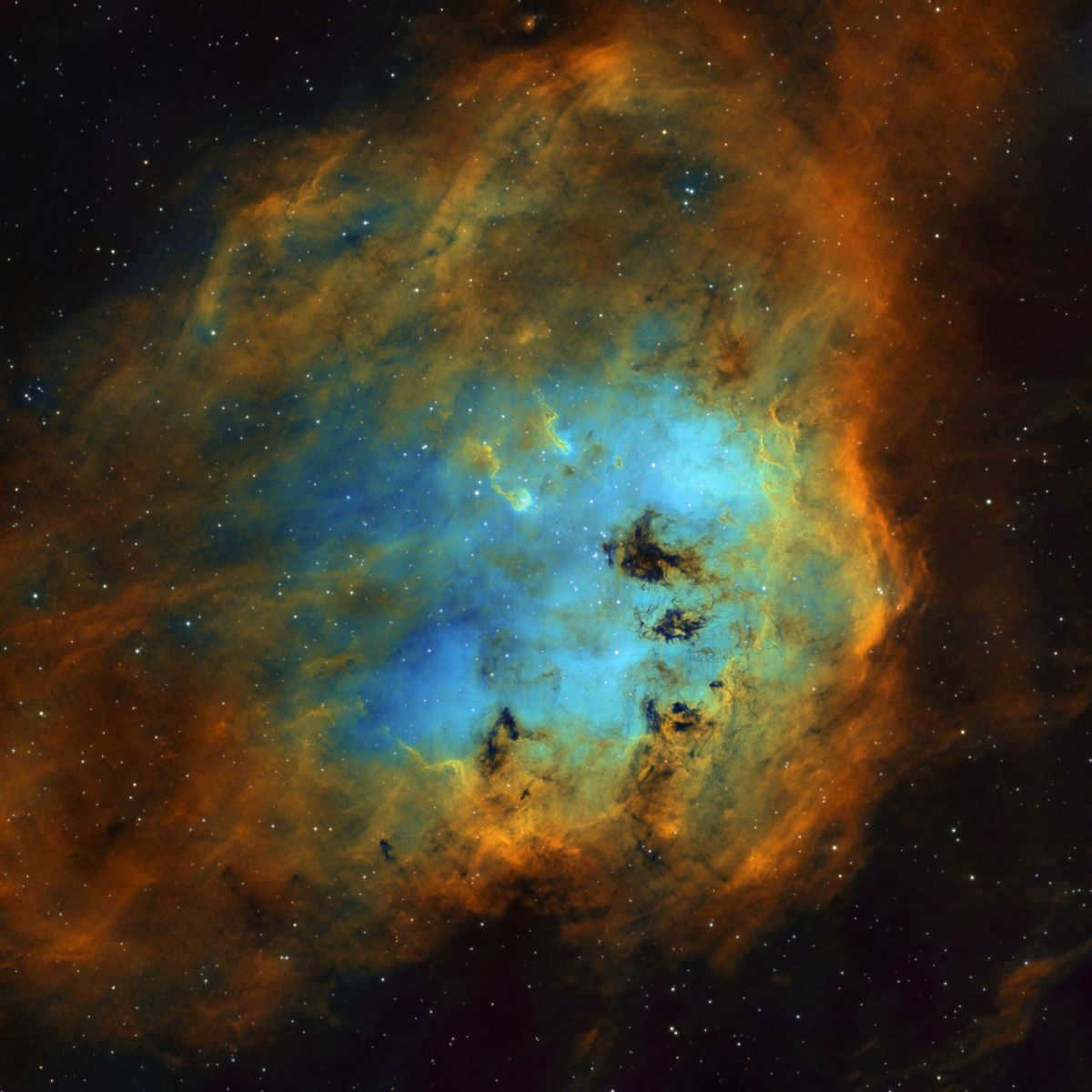
Most of the celestial bodies and other entities within the constellation of Ascendant possess distinctive parameters and physical characteristics. Astronomers continue to uncover numerous findings as they explore this particular region of the night sky.
Questions and Answers
Our galaxy, the Milky Way, falls into the category of spiral galaxies.
A cloud of ionized gas surrounding a star is referred to as a planetary nebula.
An assemblage of stars within a constellation that forms a distinct pattern is known as an asterism. For example, the Shield is an asterism within the Orion constellation.
Any planet that exists outside of our solar system and orbits its own star is classified as an exoplanet. Due to their small size and dimness, the discovery of exoplanets relies not only on observational methods but also on mathematical calculations.
The exoplanet Proxima Centauri B is the nearest known exoplanet to Earth. Located 4.2 light-years away, it revolves around the star Proxima Centauri. Despite its proximity, the planet is not visible to the naked eye or through a telescope. However, it is in close proximity to the star Alpha Centauri, which can be easily observed in the night sky.
A comprehensive overview of scientific information regarding the constellation
When we gaze up at the clear summer night sky, we can’t help but marvel at the stunning beauty of the numerous bright stars. Among them, one star stands out: Capella.
Description
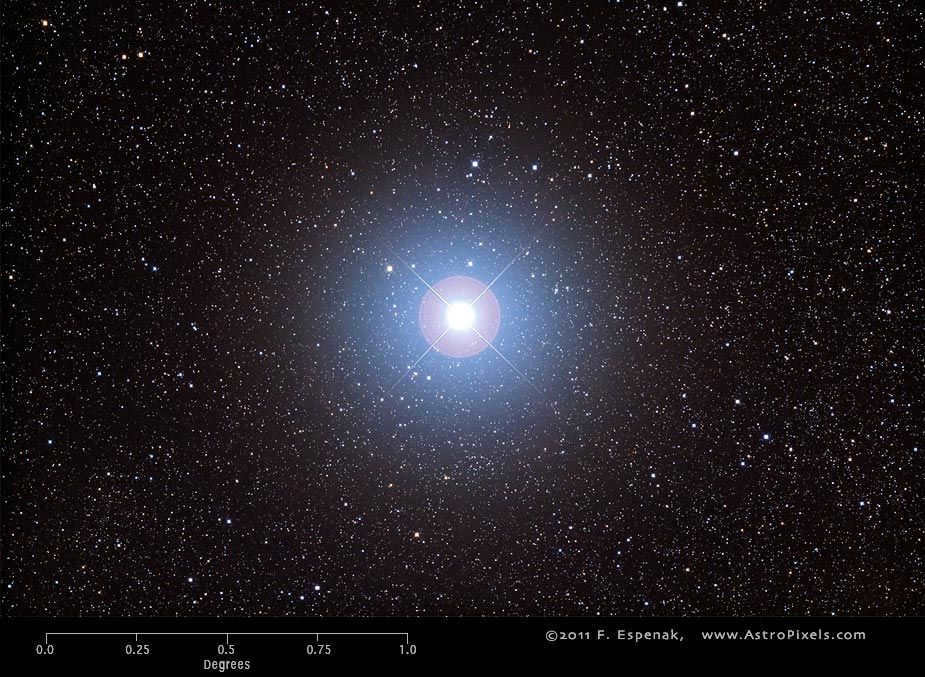
Capella, pictured by F. Espenak
This celestial body shines brightly and holds the impressive sixth position among over 20 observed stars. In terms of luminosity, Capella outshines even Betelgeuse, Aldebaran, and Fomalgaut, which are considered giants in their own right.
Capella is approximately 77 times brighter than the Sun. Both Capella Aa and Capella Ab have a mass equivalent to 2.5 times that of the Sun. The star’s radial velocity measures 30.2 kilometers per second. Capella Aa has a radius of 12.2 solar radii, while Capella Ab has a radius of 9.2 solar radii. Their temperatures are 4940 and 5700 degrees Kelvin, respectively. The star’s metallicity is only 40% of that of the Sun.
These characteristics indicate that Capella is a star that will gradually approach the end of its life, which, in human terms, will occur relatively soon.
The exceptional luminosity of the star
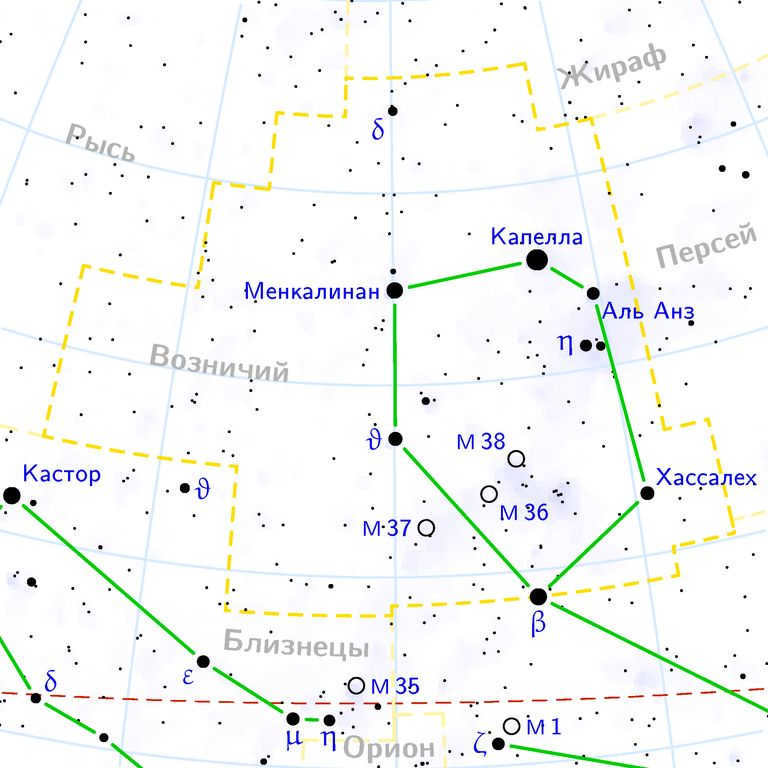
Capella is situated in the constellation of Ascendant.
Capella is positioned as the 6th most luminous star in the night sky and the 3rd most luminous star in the Northern Hemisphere. The visible magnitude of this celestial object is roughly zero. And as we are aware, the smaller the visible magnitude, the higher the luminosity of the star itself.
Resources related to the subject
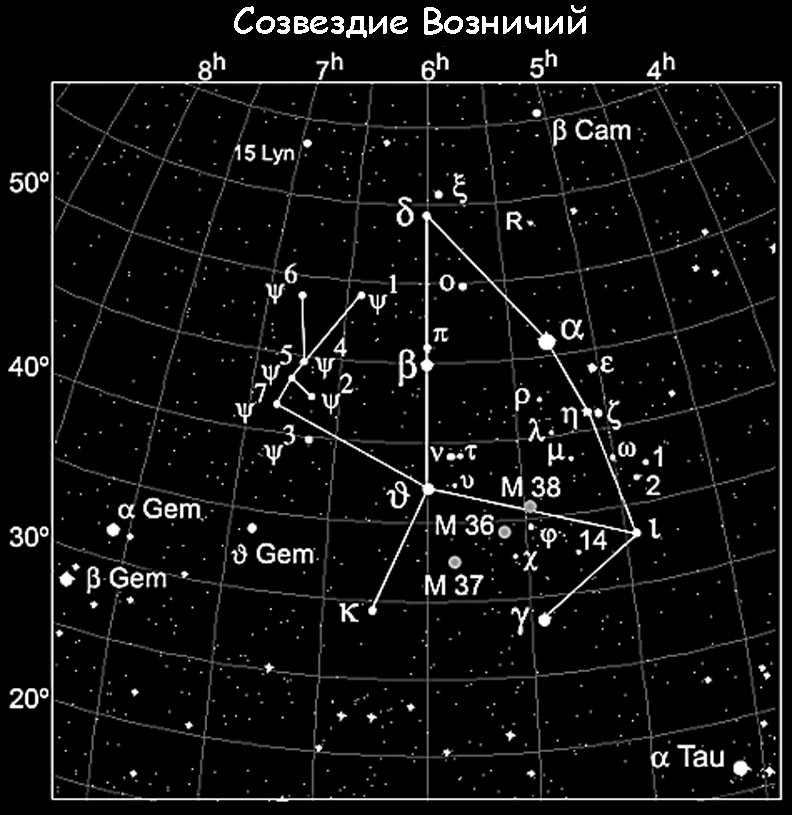
Based on certain calculations, the luminosity of Capella is estimated to be equal to that of 78 of our suns. Scientists attribute this relatively high value to a number of factors. Firstly, Capella is located at a relatively short distance from Earth, approximately 42 light-years away. Secondly, Capella is a binary star system, composed of two identical giant stars belonging to the G spectral class. Each of these celestial bodies shines with a brightness exceeding that of our Sun by a factor of 77-78. Consequently, Capella can be easily observed from our planet, even with the naked eye.
Capella: A Remarkable Double Star System
As previously mentioned, Capella is classified as a double star system. Astronomers refer to these celestial marvels as spectrally double stars or spectrally double systems. However, it is important to note that this phenomenon is not exclusive to Capella. The universe is teeming with countless similar astronomical objects, making this occurrence quite common. In fact, within our own Milky Way galaxy, the number of double and single stars is approximately equal.
The Capella star system consists of two massive stars, Capella Aa and Capella Ab. These two cosmic giants share a mutual center of mass and complete a full rotation every 104 Earth days. Positioned roughly two-thirds of the distance between the Sun and Earth, the objects are approximately 110 million kilometers apart.
Regarding the star Capella Aa, it is categorized as a red giant, having completed its evolutionary journey from a low-magnitude star to a high-magnitude one. On the other hand, Capella Ab is an unevolved star, currently in the transitional phase known as the “Hertzsprung gap,” where nuclear fusion processes have ceased but helium burning has yet to commence.
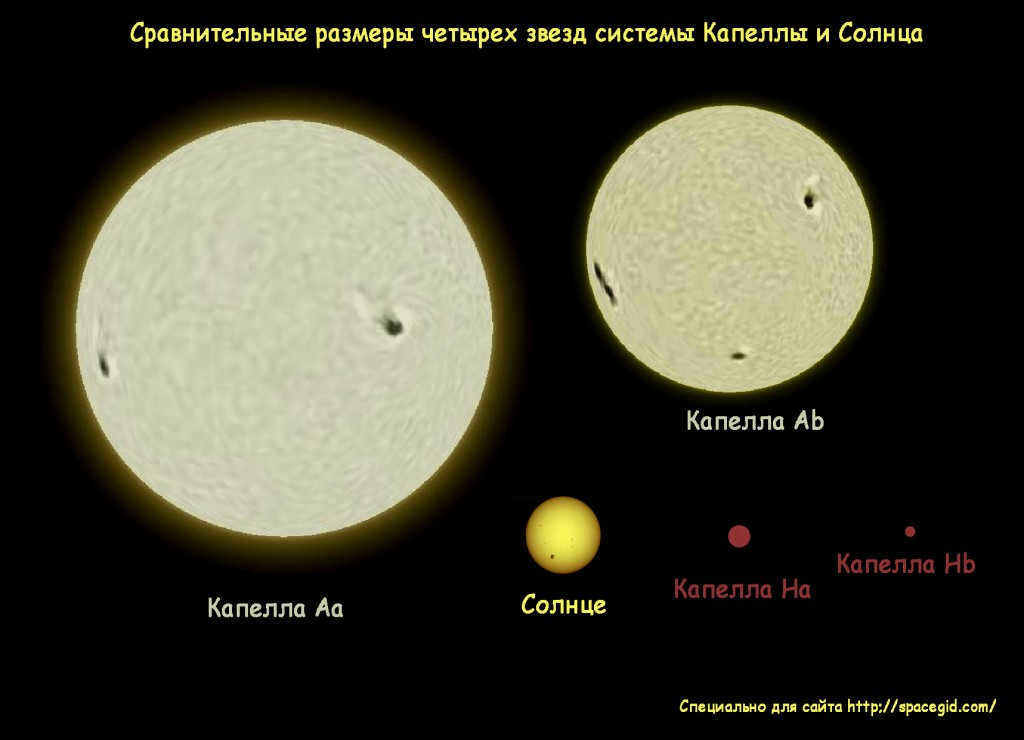
The four stars in the Capella system exhibit varying sizes as demonstrated in the image above. Despite their different stages of development, they share a similar age, approximately 5.25 billion years.
A noteworthy detail is the presence of a companion to the double star Capella. This companion consists of two class M red dwarf stars and orbits around Capella at a relatively close distance of 1 light-year.
Etymology of the Name
The star Capella derives its name from the Greek word for goat, as it is associated with the celestial goat that sits on the right shoulder of the legendary king of Athens, Erichthonius, in the constellation of Ascendant. According to Greek mythology, Erichthonius invented the world’s first chariot. In ancient times, Capella was part of a distinct asterism called “Goat with goats,” but it is now primarily recognized as part of the Ascendant constellation.
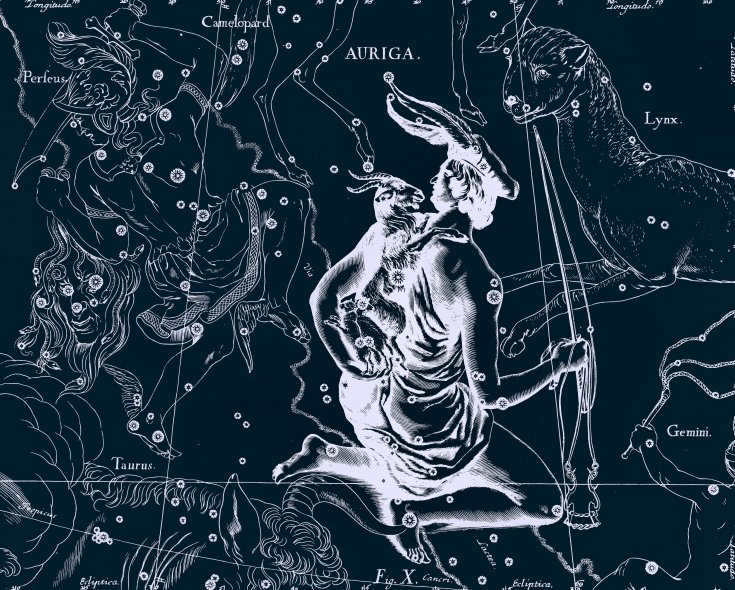
The constellation Ascendant, depicted in a drawing by Jan Hevelius in his constellations atlas
As the story goes, Capella is said to be the goat that graciously provided milk to the Greek deity Zeus while he sought refuge from his father, Cronus, on the island of Crete. In gratitude for its hospitality and nourishment, Zeus immortalized the goat in the heavens, where it now shines brightly as a star. According to the same myth, Zeus, in his immense power, accidentally broke off one of the goat’s horns during a playful encounter, which resulted in an endless shower of wealth – the cornucopia. Additionally, Zeus utilized the impenetrable goat’s skin as his shield in the epic war against the Titans.
It is evident that Capella had a significant impact on mythology, which explains why ancient people bestowed such a name upon one of the most radiant stars in the night sky.
Compilation of the most luminous stars
| 0 | Sun | 0.0000158 | -26.72 | 4.8 | G2V | |
| 1 | Sirius (α of the Big Dog) | 8.6 | -1.46 | 1.4 | A1Vm | Southern |
| 2 | Canopus (α of Kiel) | 310 | -0.72 | -5.53 | A9II | South |
| 3 | Toliman (α Centauri) | 4.3 | -0.27 | 4.06 | G2V+K1V | South |
| 4 | Arcturus (α Volopas) | 34 | -0.04 | -0.3 | K1.5IIIp | North |
| 5 | Vega (α Lyra) | 25 | 0.03 (perm) | 0.6 | A0Va | North |
| 6 | Capella (α Ascendant) | 41 | 0.08 | -0.5 | G6III + G2III | North |
| 7 | Rigel (β Orion) | ~870 | 0.12 (perm) | -7 | B8Iae | South |
| 8 | Procyon (α of the Little Dog) | 11.4 | 0.38 | 2.6 | F5IV-V | North |
| 9 | Ahernar (α Eridanus) | 69 | 0.46 | -1.3 | B3Vnp | South |
| 10 | Betelgeuse (α Orion) | ~530 | 0.50 (perm) | -5.14 | M2Iab | North |
| 11 | Hadar (β Centauri) | ~400 | 0.61 (perm) | -4.4 | B1III | South |
| 12 | Altair (α Eagle) | 16 | 0.77 | 2.3 | A7Vn | North |
| 13 | Acrux (α of the Southern Cross) | ~330 | 0.79 | -4.6 | B0.5Iv + B1Vn | Southern |
| 14 | Aldebaran (α Taurus) | 60 | 0.85 (rem) | -0.3 | K5III | North |
| 15 | Antares (α Scorpio) | ~610 | 0.96 (perm) | -5.2 | M1.5Iab | South |
| 16 | Spica (α Virgo) | 250 | 0.98 (perm) | -3.2 | B1V | Southern |
| 17 | Pollux (β Gemini) | 40 | 1.14 | 0.7 | K0IIIb | Northern |
| 18 | Fomalgaut (α of South Pisces) | 22 | 1.16 | 2.0 | A3Va | Southern |
| 19 | Mimosa (β of Southern Cross) | ~290 | 1.25 (perm) | -4.7 | B0.5III | Southern |
| 20 | Deneb (α of the Swan) | ~1550 | 1.25 | -7.2 | A2Ia | Northern |
| 21 | Regulus (α Leo) | 69 | 1.35 | -0.3 | B7Vn | Northern |
| 22 | Adara (ε of the Great Dog) | ~400 | 1.50 | -4.8 | B2II | South |
| 23 | Castor (α Gemini) | 49 | 1.57 | 0.5 | A1V + A2V | Northern |
| 24 | Hakrux (γ Southern Cross) | 120 | 1.63 (perm) | -1.2 | M3.5III | South |
| 25 | Shaula (λ of Scorpio) | 330 | 1.63 (perm) | -3.5 | B1.5IV | Southern |
If you enjoyed this post, feel free to share it with your friends!
Maxim Zabolotsky posted this entry on March 30, 2015.
Author: Maxim Zabolotsky

Located north of the Gemini constellation is a fascinating constellation that was first described by the Greek scientist Ptolemy in the 2nd century AD.
A group of stars forming a pentagon with Capella as its leader
The Ascendant constellation covers an area of 657.5 square degrees in the sky, ranking it as the 21st largest out of the 88 constellations. Under optimal visibility conditions, around 150 stars of the Ascendant can be seen with the naked eye. It is important to note that while the constellation is visible in its full glory from October to April, it is still considered a “winter” constellation. The best months to observe it are December and January.
Observation
My observation has led me to conclude that…
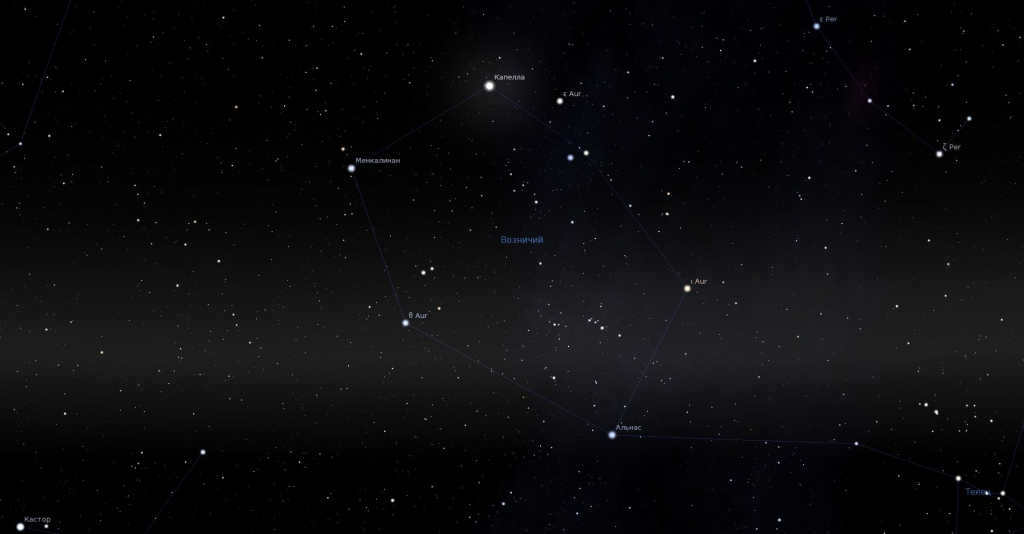
Ascendant, observation within the planetarium software
The Ascendant constellation can be easily observed from all over Russia. Despite the presence of only one bright star, Capella, which is of the first magnitude, it is difficult to find stars brighter than the fourth magnitude within this constellation.
Difficulties in observing this celestial object may only occur during summer nights in June and July, when the constellation descends too low on the horizon. Even for a novice astronomer, it is not challenging to locate a constellation in the night sky: simply extend the imaginary line from the beta and alpha stars of Ursa Minor towards the east from the constellation Perseus, and you will come across the distinctive pentagon of stars that make up Ascendant. Additionally, you can use the neighboring constellations of Taurus, Gemini, Lynx, and Giraffe to help orient yourself.
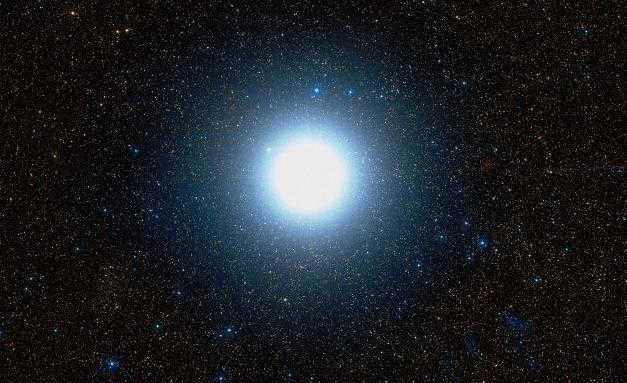
Capella, also known as Alpha Ascendant, is depicted on ancient maps as a man kneeling and holding a stirrup and bridle in one hand, and a pair of small goats in the other. One of these adorable creatures represents the brightest star in the Ascendant constellation, Alpha Ascendant, which is the sixth brightest star in the entire sky. Alpha Ascendant, or Capella, is a yellow giant star and is classified as a first magnitude star, making it one of the closest stars to the North Pole. It has been observed and documented since 2000 BC.
Characteristics of Capella
Capella is a binary star with a distinct yellow hue, which has often drawn comparisons to the Sun. However, despite their similar color and surface temperature of 5700 K, Capella and the Sun differ greatly in other aspects. Capella is 150 times brighter and 2.5 times more massive than the Sun.
Although Capella is classified as a binary star, its two components are positioned so closely together that they cannot be individually discerned even with a powerful telescope. The classification of Capella as a binary star is solely based on the analysis of its spectrum. Both components in this double system are classified as giant stars of the G class, with a rotation period of 104 days. Capella is located 45 light-years away from Earth.
Star Menkalinan
The celestial body known as Menkalinan is a star that shines brightly in the night sky. It is a prominent feature of the constellation Auriga and has captivated astronomers and stargazers for centuries. This dazzling star has been a subject of fascination and study, with scientists eager to unlock its secrets. Its luminosity and position in the heavens make it a captivating sight for those who gaze upon it. Menkalinan is a testament to the vastness and beauty of the universe, reminding us of the wonders that exist beyond our own planet.
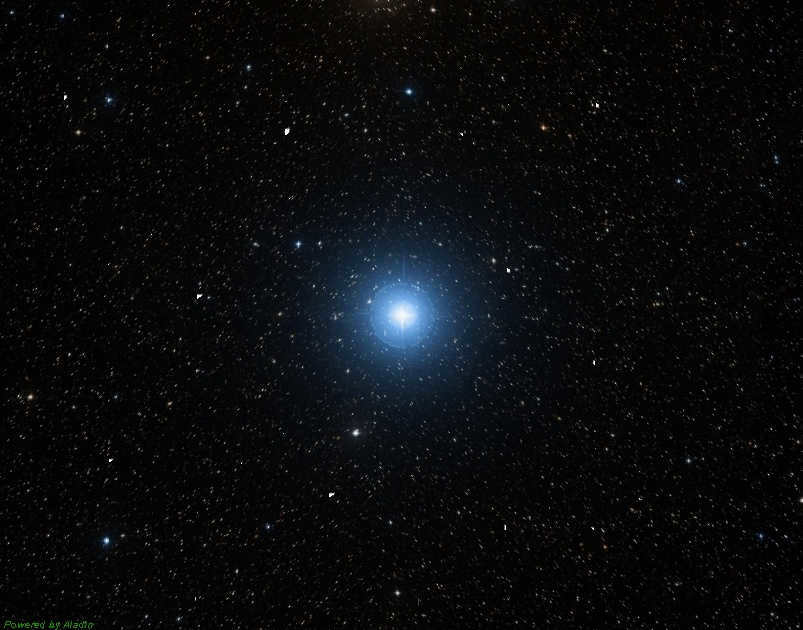
Photo of Beta Ascendant or Menkalinan
The constellation we are considering is home to a star known as Menkalinan, but it is also referred to as Beta Ascendant in astronomy. Menkalinan is the second brightest star in this constellation, with a stellar magnitude of 1.90m. It belongs to the spectral class A and has a surface temperature of 9200 K. Menkalinan is actually a triple star system and is located 82 light-years away from our solar system. It shines 95 times brighter than the Sun.
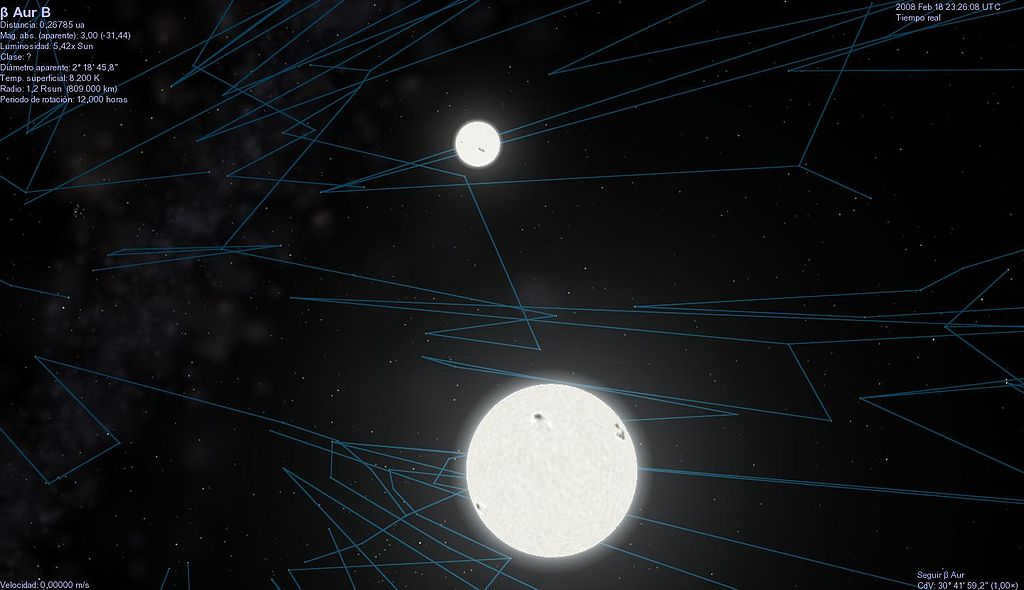
In the Celestia program, the Beta Ascendant system showcases a unique phenomenon. Every four days, observers can witness a partial eclipse and a significant change in stellar luminosity by 0.1m. This led scientists to determine that the system consists of two nearly identical stars, each with a luminosity approximately 48 times greater than that of the Sun. The distance between these stars is remarkably small, measuring only 0.08 astronomical units. Currently classified as white subgiants, these stars are gradually increasing in size due to the active process of hydrogen burning deep within their cores.
If these two elements are in such close proximity that they can even mutually affect the form of the “neighbor,” the third element of the system is situated quite a distance away from them. The third link in the Menkalinan system is a red dwarf, positioned 330 astronomical units from the other two elements. This star is undetectable without the utilization of optics. It is significant to note that there are conjectures regarding the affiliation of the beta of Ascendant with the mobile group of stars in the constellation of the Big Dipper.
Almaaz, also known as Epsilon from Ascendant.
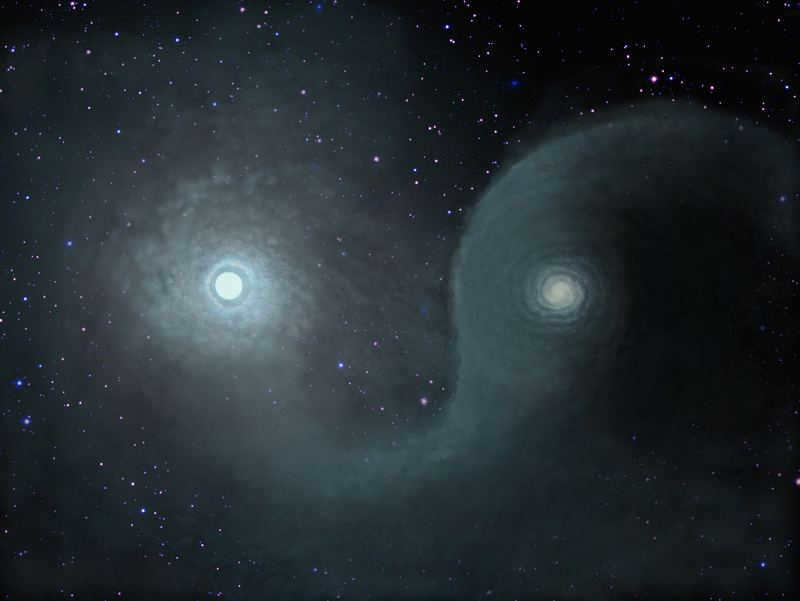

This is the depiction of the Epsilon Ascendant system by the artist.
Another star in the Ascendant constellation is of great interest. Epsilon Ascendant, classified as an eclipsing variable star, stands out. With a rotation period of 27 years, it holds the record for the longest rotation period among similar stars. Consequently, every 9883 days, the apparent brightness of Epsilon Ascendant decreases by 0.9m, fluctuating between magnitudes of 2.92m and 3.83m. The duration of the eclipse, when one component passes in front of the other, can range from 640 to 730 days. Epsilon Ascendant is located approximately two thousand light-years away from Earth.
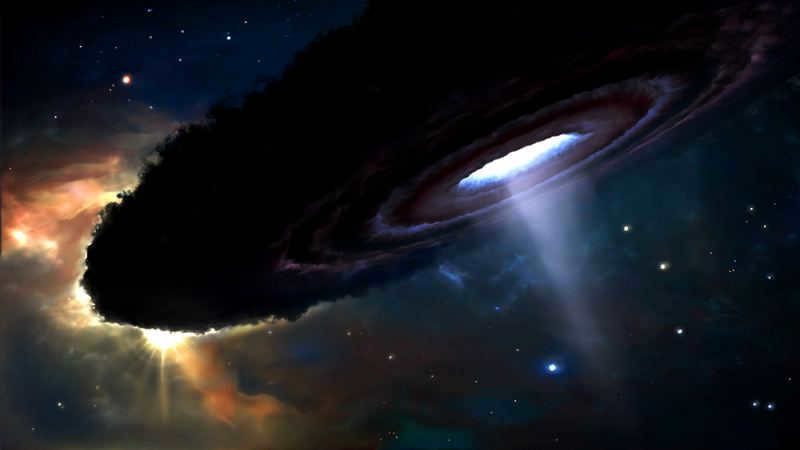
Epsilon Ascendant, an illustration by the artist
The primary star in the Almaaz star system is a visible giant luminary, with a magnitude of four. It has a luminosity that is approximately 1,200 times greater than that of the Sun and a temperature of 6,300 K. The secondary star is the largest supergiant known to exist. What’s fascinating is that despite its enormous size, this star is not visible to the naked eye and is also difficult to observe even with the most advanced telescopes. The reason for this is that it is in close proximity to the primary star and has a relatively low temperature of 1,350 K.
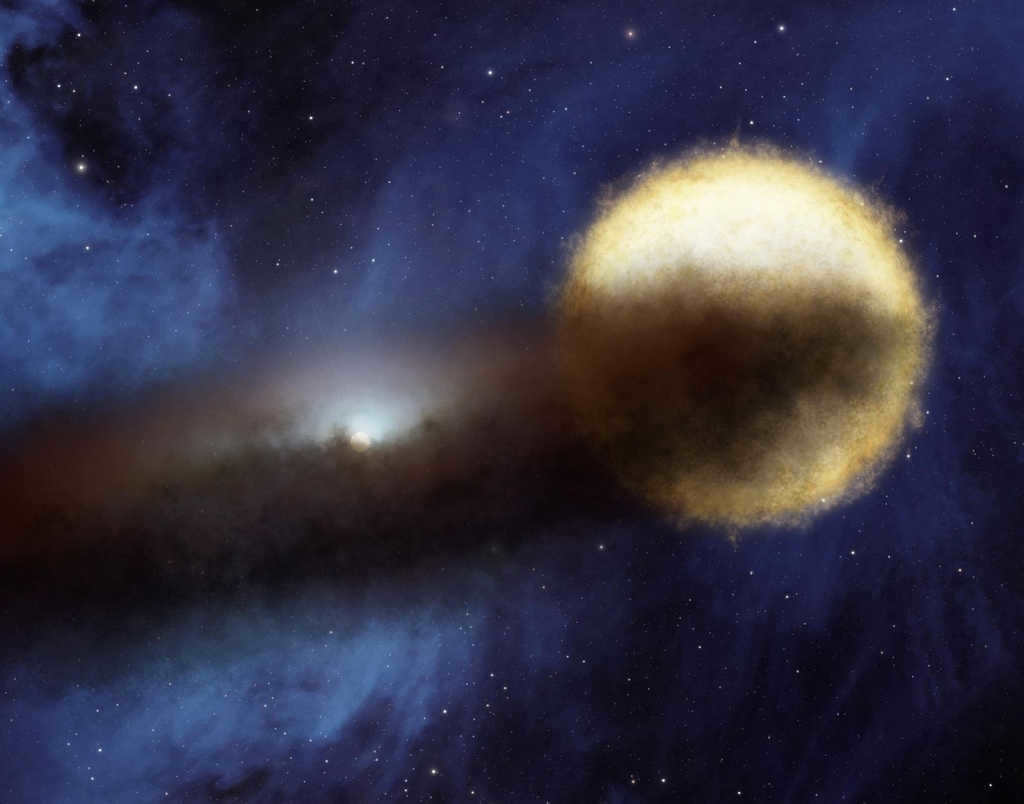
Episilon of Ascendant, artist’s illustration
A supergiant in the epsilon of Ascendant system is a star that has almost completely cooled down and now emits only invisible infrared radiation.
Clusters, galaxies, exoplanets – a wealth of celestial objects in Ascendant
The galaxy cluster MACS 0717
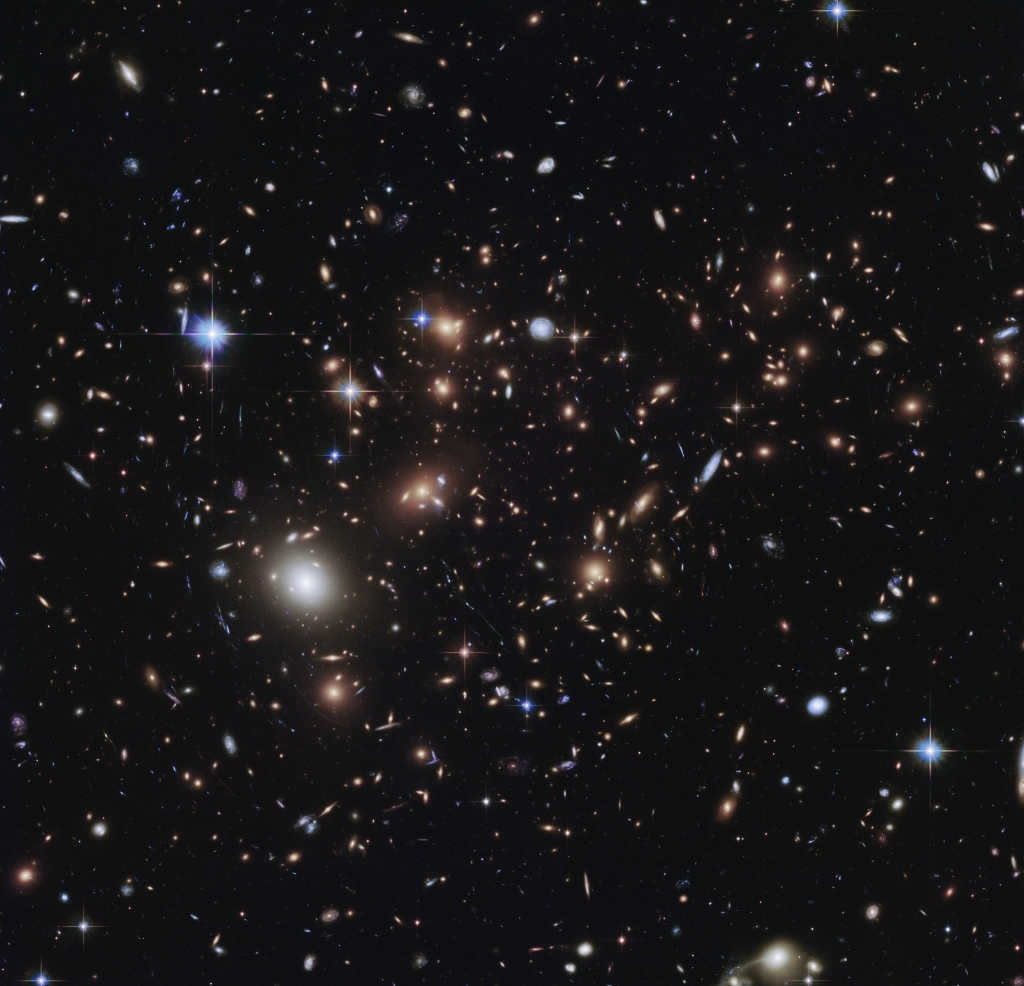
Situated in the constellation of Ascendant, at a distance of 5.5 billion light years away from our planet, lies an exceptionally massive galaxy cluster known as MACS 0717. This particular cluster stands out among its peers due to its unique composition, consisting of not one, not two, but four distinct clusters. This astronomical marvel, never before observed in history, has captured the attention of scientists worldwide. Bearing the name MACS 0717 (also referred to as MACS J0717.5+3745), this cluster boasts a staggering mass that is millions of billions of times greater than that of our own Milky Way galaxy. Experts have identified three fixed components within the cluster, labeled as subgroups A, D, and C, as well as a mobile subgroup B. It is worth noting that subgroup B is being gravitationally pulled towards the larger cluster, resulting in its rapid movement at an astonishing speed of 3000 km/s.
Nebula IC 2149
can be rephrased as
IC 2149 Nebula
.
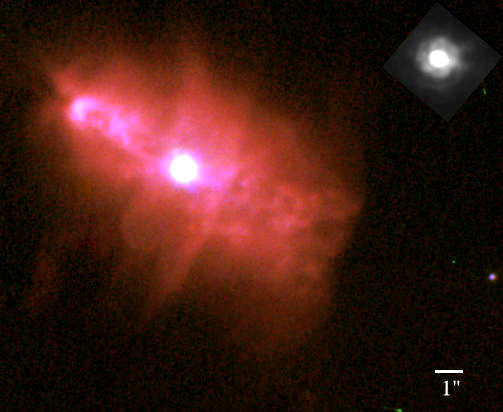
IC 2149 is a planetary nebula located in the Ascendant constellation. It is a small and bright nebula that can be easily observed using small telescopes. While it may initially appear as a 12 magnitude star, a careful observer will notice its unique color that sets it apart from regular stars. Even at low magnification, it is possible to see a small elongated disk surrounding the central star of the nebula. As the magnification increases, the nebula starts to “blink” – when looking directly at it, only the bright central star is visible, but by slightly shifting the view, the egg-shaped nebula surrounding it becomes distinguishable as well.
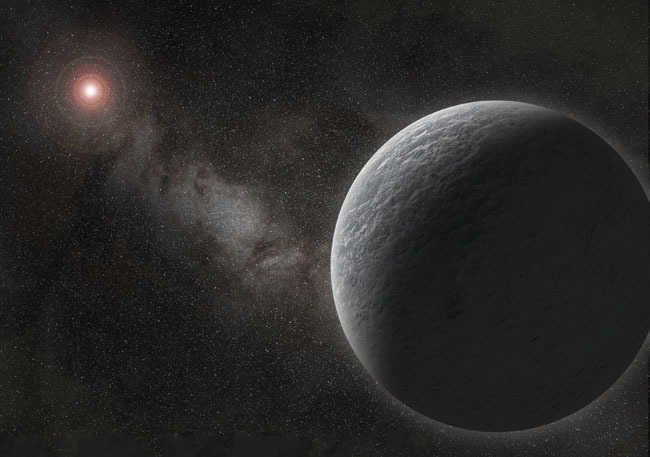
GD 66 b as depicted by the artist
Moreover, a newfound exoplanet has been detected orbiting the white dwarf star GD 66b. This finding is significant since exoplanets have not been observed in white dwarfs before, and GD 66b is one such star.

Jan Hevelius created a drawing of the Ascendant constellation for his atlas of constellations.
When it comes to the origin of this constellation, there are currently four main stories, all of which are closely tied to Greek mythology. The majority of these stories involve the mythological god-craftsman Hephaestus or his sons. In some versions, Hephaestus is credited with inventing the first chariots, while in others, his sons Myrtil or Erichthonius are mentioned as charioteers. Additionally, in Chinese mythology, it is believed that the four stars of Ascendant, along with one star from Taurus, form the ancient constellation of Five Chariots, which honors the five emperors of the Celestial Empire.
Capella (Alpha Ascendant) holds the title for being the most prominent star in Ascendant and the sixth brightest star in the sky. In the northern hemisphere, it is only outshined by Arcturus and Vega. Some people refer to it as the “goat star.”
Although it appears to be a single entity, Capella is actually a binary star system consisting of four components. It is located approximately 42.2 light-years away from Earth and has an apparent magnitude of 0.08. Capella is not visible below 44°S, but it is constantly visible above 44°N and never sets below the horizon.
In regions with mid-northern latitudes, the optimal time to observe Capella is during the winter season when it is almost directly overhead. One can locate Capella by following the Big Dipper asterism in the constellation Ursa Major. By drawing a line through the stars Megrez and Dubhe, you will eventually reach Capella.
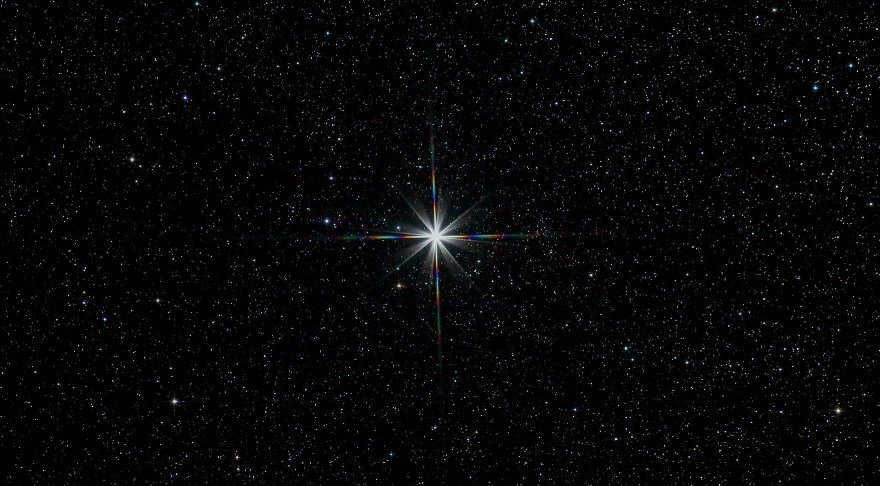
Capella is located in the constellation Ascendant and represents the goat that the constellation carries on its shoulder. In Greek mythology, it was associated with Almathea, the Cretan goat that nurtured Zeus when he was a baby.
There is another myth in which Capella was a nymph who owned a goat. She was so repulsive that she frightened the Titans and helped them win the war.
Capella, along with Epsilon, Zeta, and Aeta of Ascendant, forms an asterism. It used to be a separate constellation, but in the 2nd century, Ptolemy merged it with Guardian. There are no planets or satellites in the Capella system.
Capella star system
Capella is a star system that consists of two binary systems. The main pair consists of two bright giants with a spectral class of G. These stars are in a close orbit and are currently undergoing expansion. In the future, they will evolve into red giants.
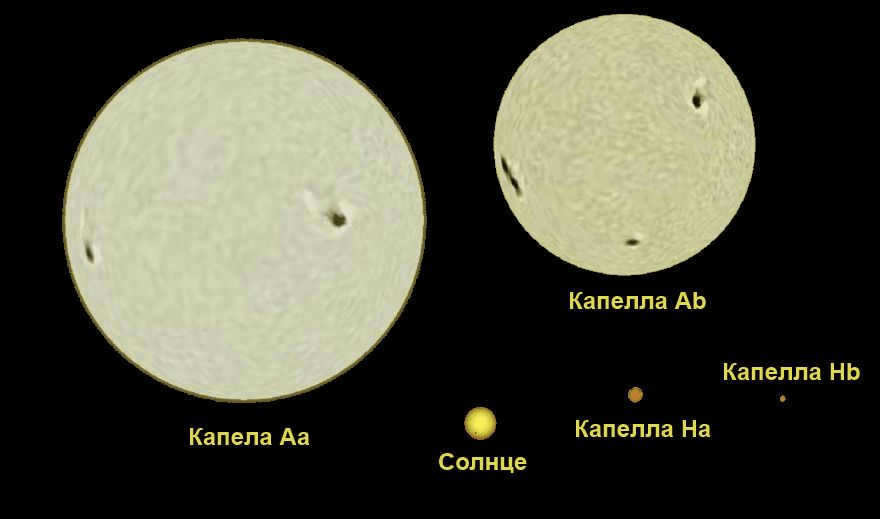
Comparison of the dimensions of the Sun and Capella (Aa, Ab, Ha, Hb)
The stars are identified as Aa and Ab. They have a mass 2.5 times greater than that of the Sun. Aa has a diameter 12.2 times that of the Sun, while Ab has a diameter 9.2 times that of the Sun. The primary star is 78.5 times brighter than our own, and the companion is 77.6 times brighter. The apparent magnitude of the former is 0.91, and the visual magnitude of the latter is 0.76.
There is a distance of 0.72 astronomical units between them, and they take 104 days to complete one orbit. The age is estimated to be around 400 million years. Despite their relatively young age, they are already approaching the end of their lifecycle.
Facts
Discover some fascinating information about the Capella star. Additionally, utilize the star chart on the webpage to locate the star through a telescope. Alternatively, access the online 3D models to investigate the visual characteristics and position of Capella and the Ascendant constellation in the vastness of space.
Capella, situated 42.2 light-years away, shines as the most luminous yellow star.
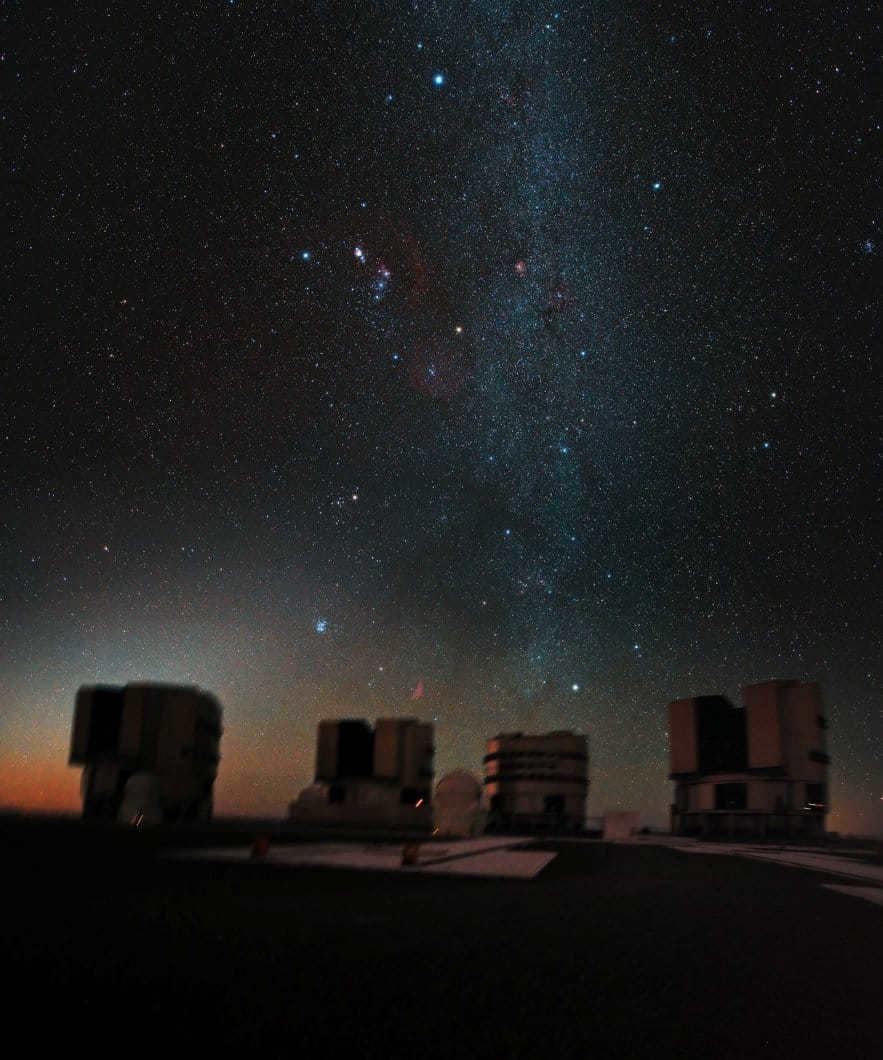
Capella is currently moving through the Milky Way galaxy at a velocity of 39.7 km/s, and its orbit spans a distance of 21900-27100 light-years from the center of the galaxy. The closest approach to the Sun occurred approximately 237,000 years ago, bringing the distance between Capella and the Sun down to just 29 light-years.
The star’s dual nature was initially hypothesized by William Campbell in 1899. It wasn’t until 1919 that John Anderson and Francis Pize were able to confirm this and publish the orbital data in 1920. In 1974, X-rays were detected emanating from Capella, believed to originate from the corona of a massive star. It is possible that Capella Aa and Ab contribute to the activation of the Aa corona, resulting in X-ray luminosity that is 10,000 times greater than that of the Sun.
In 1914, Ragnar Furuchelm observed that a spectroscopic double system had a faint companion with a physical connection. This finding was later confirmed by Kuiper in 1936.
Capella, the closest first magnitude star to the North Pole, is located on the opposite side of Vega. Approximately 210,000 years ago, it shone the brightest with a visual magnitude of -1.8. In 1960, Odin Eggen made the discovery that Capella is a part of the moving Hyades group.
Even before Ptolemy, Capella was known as a goat star. Pliny the Elder and Manilius referred to it as the star Capra. In Mesopotamia, it was given the nickname GAM, which means “the rogue” or “yatagan.” Among the Bedouins, all the stars in the Ascendant were associated with goats. The Arabs called it al-qayyuk. In Macedonia, the star was known as Hawk, as it appeared poised to attack Mother Hen (Pleiades – M45).
The Chinese referred to it as the Wu Chai, the Second of the Five Chariots. In Hindu mythology, it was known as the Heart of Brahma. In the land of Australia, it was seen as Purra, the kangaroo, and it was pursued by the brothers Jurri and Wangel, also known as Castor and Pollux. In Hawaii, it was called Hoku-lei, meaning “star wreath”.
Capella was first mentioned in an Akkadian inscription in the 20th century BC. In English literature, it was often referred to as “the shepherd’s star”. There are mentions of Capella in works such as E. Armond’s “Exiles of Capella”, R. Heinlein’s “Star Soldiers”, D. Gunn’s “Listeners”, and others.
Physical characteristics and orbit
- Capella A – 05h 16m 41.3591c (right ascension), + 45° 59' 52.768" (declination).
- Capella H – 05h 17m 23.728c (right ascension), + 45° 50' 22.97" (declination).
- Capella L – 05h 17m 23.77c (right ascension), +45° 50' 29.0" (declination).
- Spectral class: G8III/K0III (Aa), G1 III (Ab), M1 (H), M5 (L).
- Visible magnitude: 0.91 (Aa), 0.76 (Ab), 0.08 (0.03-0.16 – Aa and Ab), 10.16 (H), 13.7 (L).
- Absolute value: 0.35 (Aa), 0.20 (Ab), -0.48 (A), 9.53 (H), 13.0 (L).
- Capella A is located 42.2 light-years away.
- Capella HL is located 45 light-years away.
- Massiveness: 2.69 solar (Aa), 2.56 (Ab), 0.53 (H), 0.19 (L).
- Radius: 12.2 solar (Aa), 9.2 (Ab), 0.54 (H).
- Luminosity: 78.5 solar (Aa), 77.6 (Ab), 0.05 (H).
- Temperature mark: 4940 K (Aa), 5700 K (Ab), 3700 (H).
- Rotational velocity: 3 km/s (Aa), 36 km/s (Ab).
- Orbital period: 104.022 days (Aa and Ab), 388 years (HL).
- Variable Type: RS of the Hound Dogs (A).
- Capella Aa and Ab – Capella, Alpha Ascendant, α Ascendant, 13 Ascendant, HD 34029, HIP 24608, ADS 3841 AP, BD + 45° 1077, CCDM J05168 + 4559AP, FK5 193, GC 6427, GJ 194, HR 1708, IDS 05093 + 4554 AP, LTT 11619, NLTT 14766, PPM 47925, SAO 40186, WDS 05167 + 4600Aa/Ab.
- Capella HL – ADS 3841 HL, CCDM J05168 + 4559HL, GJ 195 AB, WDS 05167 + 4600HL.
- Capella H – G 96-29, LTT 11622, NLTT 14788, PPM 47938.
The winter constellation Ascendant is at its best for viewing in December-January, although it has been visible in the eastern sky since the autumn. It is the 21st largest constellation out of the 88 constellations, so there are some interesting objects to observe, although not as awe-inspiring as those in Orion or Taurus, for example.
It was named after the mythical figure Erichthonius, who was credited with inventing the two-wheeled chariot and was placed in the sky by Zeus as a reward for his cleverness. This invention ultimately helped Erichthonius win a war and become the king of Athens.
The position of the Ascendant constellation in the celestial sphere
Situated above the Orion and Gemini constellations, and to the left of Taurus with the prominent Aldebaran, the Ascendant constellation can be easily identified. It stands out due to its distinctive pentagonal configuration of stars, with Capella, the most luminous star in the constellation and one of the most brilliant stars in the entire sky, shining radiantly in the upper corner.
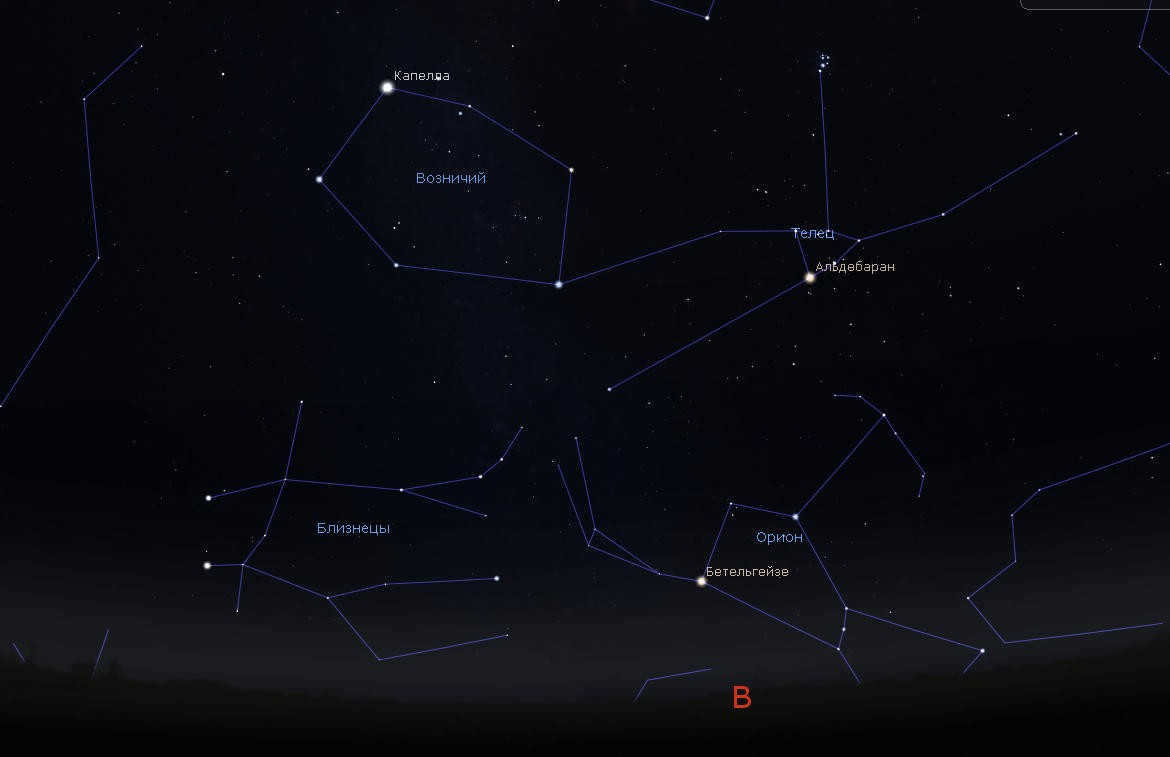
The constellation Ascendant is visible in the sky.
Within the constellation of Ascendant, there are several unique stars and a few objects listed in Messier’s catalog that can be observed by beginner amateur astronomers.
Ascendant’s Stellar Phenomena
This constellation boasts a collection of intriguing stars. While they may appear similar to other stars, it is still worthwhile to locate and observe them for educational purposes.
Capella is the most brilliant celestial object in the constellation of Ascendant
Long long ago, approximately 210,000 to 160,000 years in the past, Capella shone as the most radiant star in the firmament, although it was visible solely to the dinosaurs. Back then, this star’s proximity to us was just 28 light-years, but since then, its distance has expanded significantly.
Presently, this stellar body lies at a distance of 42 light-years and is in fact a binary star. Indeed, it cannot be perceived through a telescope, as the constituents of this system are positioned at a mere 2/3 of the distance between Earth and the Sun, approximately 100 million kilometers.
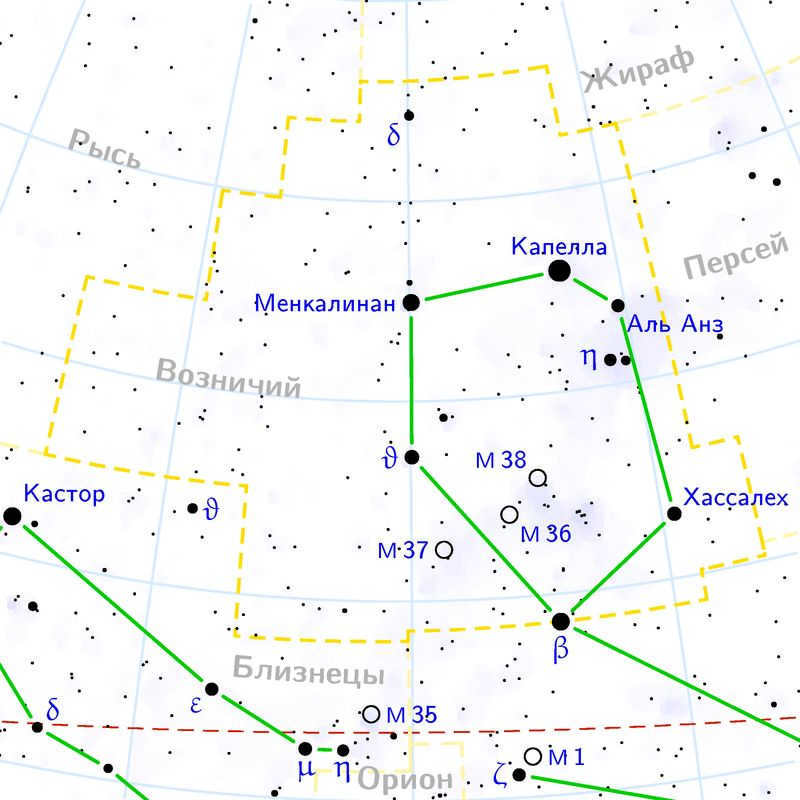
The Capella system consists of two giant stars, with one being 77 times brighter than the Sun and the other 78 times brighter. Component A is a red giant that has already exhausted its hydrogen fuel and is currently undergoing helium burning. Component B is also following a similar path, where the hydrogen has been depleted but helium reactions have yet to occur. Both stars have a mass 2.5 times greater than the Sun and orbit around their center of mass every 104 days.
Due to their close proximity, it is possible that the expanding envelopes of these two giants may eventually touch, although this is not expected to happen in the near future.
Located 1 light-year away from the pair of colossal stars lies another pair of stars – red dwarfs, which are also intimately linked to each other. Additionally, this pair also possesses a shared center of gravity with the pair of giants. Consequently, Capella is, in fact, a quadruple star system comprising a duo of red giants and a duo of red dwarfs.
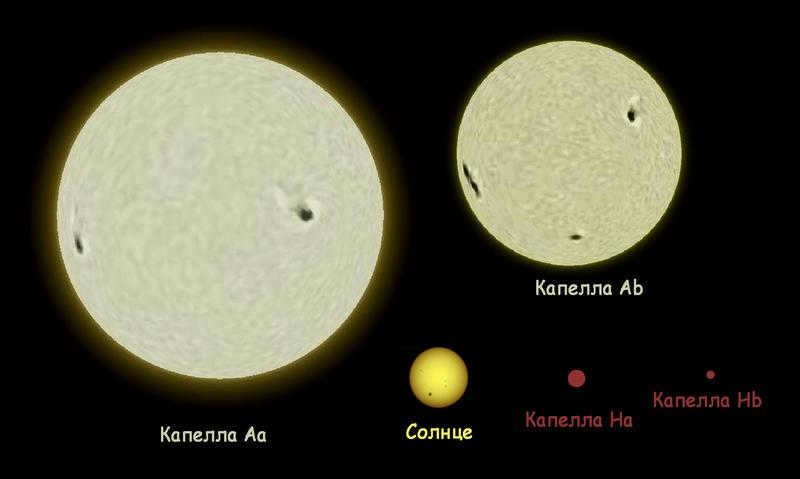
The relative sizes of the elements within the Capella system compared to the Sun.
Beta Ascendant – Menkalinan
This particular celestial body is known as Menkalinan and is a triple star system. At the center of this system, there exists a pair of subgiants that are 48 times more luminous than the Sun. These stars have depleted their hydrogen supply and have expanded in size. Interestingly, they are positioned very closely to each other, only 0.08 astronomical units apart, which is 5 times smaller than the distance between the Sun and Mercury.
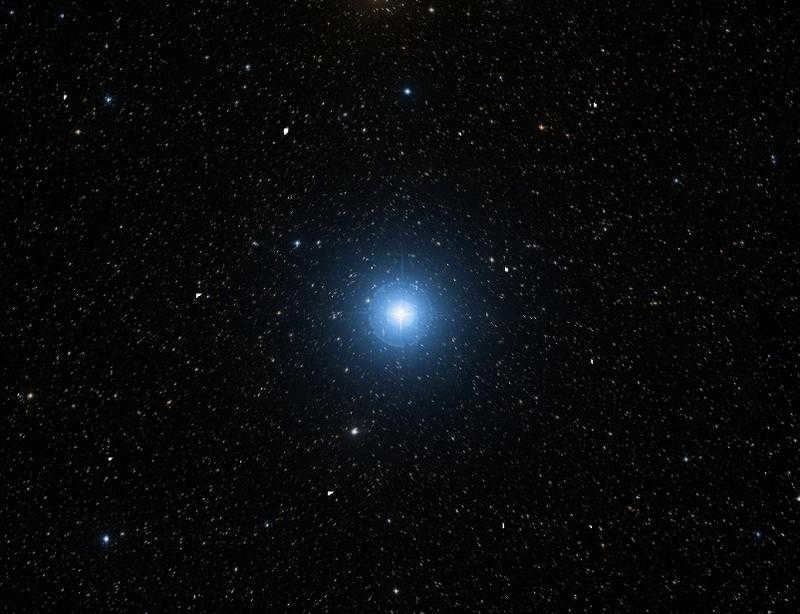
Beta Ascendant – Menkalinan
Due to their close proximity, the gravitational pull between the stars is so strong that they have an elliptical shape and are positioned slightly off-center. As they continue to expand, it is likely that they will eventually make contact, similar to what happens in the Capella system.
Menkalinan is located in a region of space where one star eclipses the other every 3.96 days, causing a temporary decrease in overall brightness of 0.1m. This makes it an eclipse-variable star.
About 330 astronomical units away from this pair of large stars is another star – a red dwarf. Without a telescope, it is not visible to the naked eye.
Epsilon of Ascendant – Almaaz.
The star Epsilon of Ascendant, known as Almaaz, possesses its own distinct identity. Located approximately 2000 light years away, its visibility to the naked eye despite its significant distance is a testament to its remarkable qualities.
Almaaz is classified as an eclipsing variable star, composed of two distinct components. The primary component is a luminous white supergiant, exhibiting pulsations with a period of 66 days. This star surpasses the Sun in size, measuring 100-200 times larger, and in brightness, radiating 40-60 thousand times more luminosity!
The secondary component, however, remains enigmatic in nature, baffling astronomers for an extended period. It was initially speculated to be either a black hole or an immense translucent star.
The reality is that eclipses occur once every 27 years, causing the brightness of Almaaz to decrease from 2.92m to 3.83m, and they can last for a duration of 640-730 days. This indicates that the second component is positioned at a significant distance from the first. In order to eclipse a supergiant from such a distance for such an extended period of time, it would need to possess an extraordinary size.
Currently, there exists a hypothesis that suggests the second component within the Epsilon of Ascendant system is a binary system surrounded by a dust disk. During the occurrence of these events, a colossal nebula passes in front of the supergiant, resulting in a reduction of its brightness, which we observe approximately every 27 years.
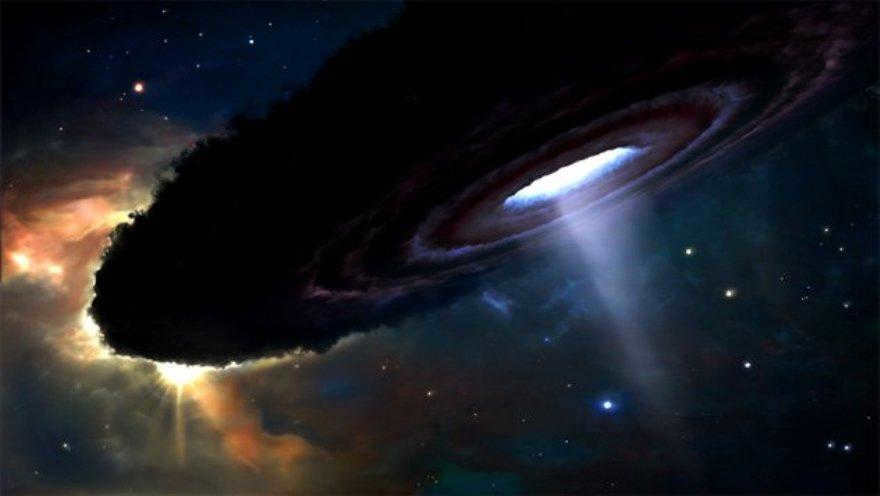
This might be the appearance of the second element of the Epsilon Ascendant system.
Epsilon Ascendant is a star that captures a great deal of attention from astronomers. Not everything here is as straightforward as it may appear. The nature of the system’s second element remains unclear, as it is challenging to observe. In recent times, numerous hypotheses have been proposed, but none have been substantiated. The theory regarding the dust disk remains the most plausible, yet further investigation is also necessary. When you come across this star in the night sky, bear in mind that it is one of the most enigmatic objects, harboring numerous mysteries.
The star ζ of Ascendant is known as Hedus (or Sadatoni in Arabic). It is also a remarkable star, or more accurately, a binary system that appears as an eclipsing variable. It is situated at a considerable distance from us – 784 light-years away.
The primary component of this system is a luminous orange giant, which is 148 times larger than the Sun, nearly 6 times more massive, and 4800 times brighter. The secondary star is a hot blue-white star, only 4.8 times more massive than the Sun and 4.5 times larger, but it is also 1000 times brighter than our star.
The orbital period of this binary system is 2.66 years. While this system may not possess the intrigue of Epsilon of Ascendant, it is still an incredibly impressive pair of stars. This system is a scorching hot environment.
Star clusters in the Ascendant constellation
The Ascendant constellation contains three separate star clusters – M36, M37, and M38. These clusters are in close proximity to each other and form a nearly triple cluster. The most luminous cluster among them is M37.
